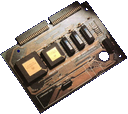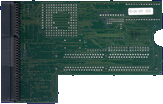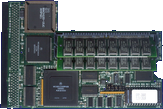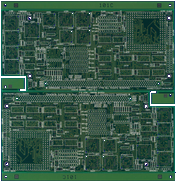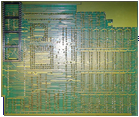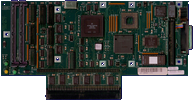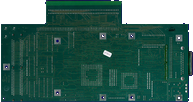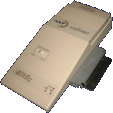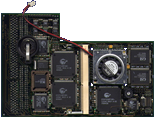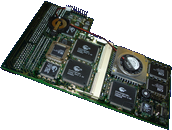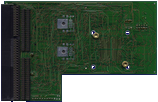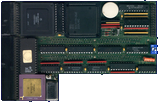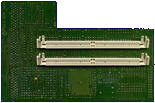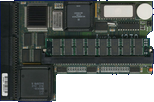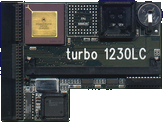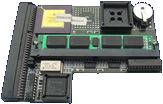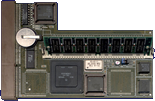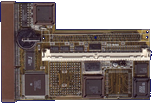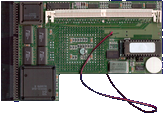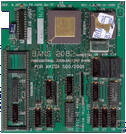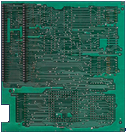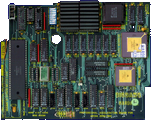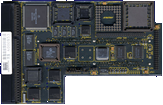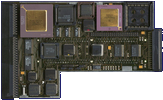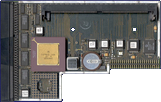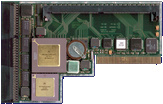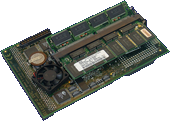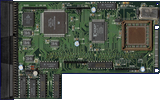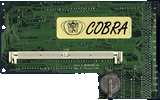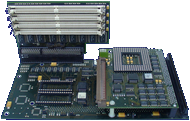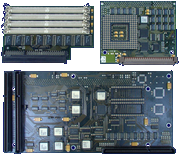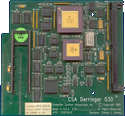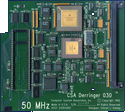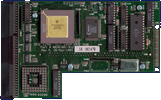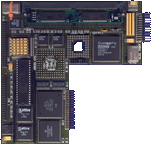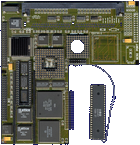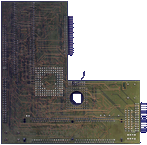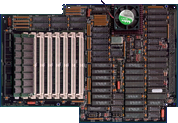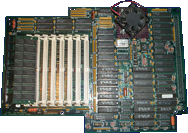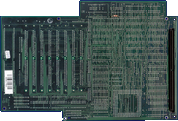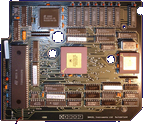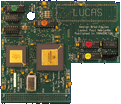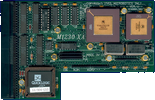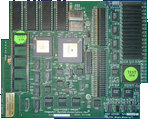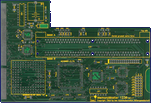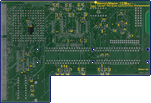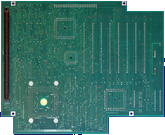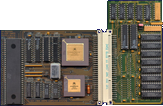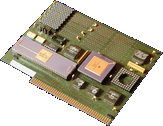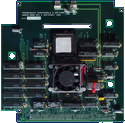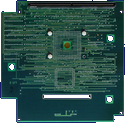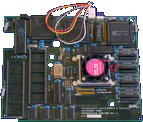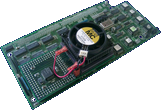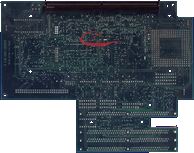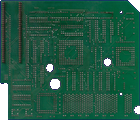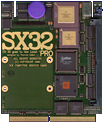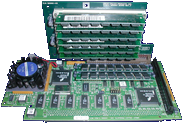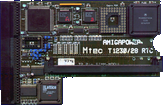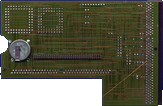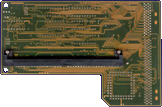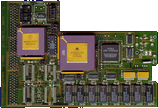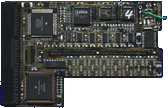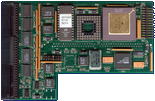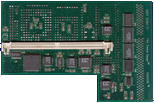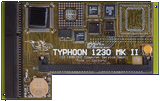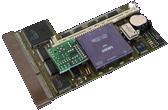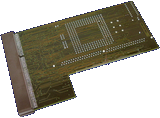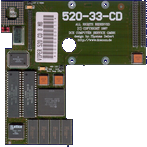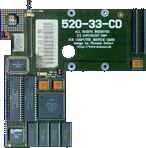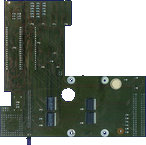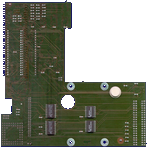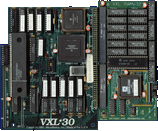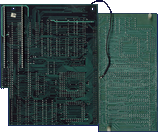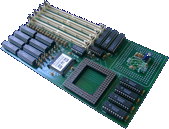Search Result
161 expansions found
Company ACL Distribution, UK | Date 1995 | Amiga A1200 | Interface trapdoor slot |
- processor
- 68030 @ 50 MHz PGA
- 68882 @ 40 / 50 MHz PGA
- memory
- two 72 pin SIMM sockets accept 64 MB RAM
- supports EDO RAM
- notes
- optional SCSI 2 / EIDE controller
- battery backed up clock
Company Computer System Associates, USA | Date 1991 | Amiga A2000 | Interface CPU slot | Autoconfig ID 1058 / 17 |
- processor
- 68040 @ 25 / 33 MHz
- memory
- four 72 pin SIMM sockets accept 64 MB RAM
- supports 4 or 16 MB SIMMs (1M×32 resp. 4M×32)
- SIMM sizes can be mixed
- 1 MB burstable static RAM, soldered to the board
- 32 bit feature connector for extra memory board adding up to 128 MB RAM
- supports normal, page and burst modes
- Fast SCSI 2 controller
- NCR 53C710 controller IC
- 50 pin internal header
- DB25 external connector
- socketed resistors for SCSI termination
- LED bank indicate SCSI bus activity
- supported by NetBSD and OpenBSD
- I/O
- one DB25 RS422 compatible parallel port - plus one optional
- one DB9 RS232 compatible serial port - plus two optional
- notes
- LED bank indicate system bus activity
- programmable EPROM
- 68000 fallback mode, selectable by jumper or software
- pressing left mouse button during startup disables autoboot
- Autoboot disable switch at slot cover
- the board's autoconfiguration can be disabled by jumper
- 40_4_Magnum.pdf
user manual
146 kB
- 40_4_Magnum.dms
install disk
csascsi.device v38.76 (8 Sep 1992), csaser.device v1.52 (8 Jan 1992), csaprint.device v1.0 (28 May 92)
311 kB
Company Computer System Associates, USA | Date 1986 | Amiga A1000 | Interface 68000 socket |
- processor
- 68020 @ 7.14 MHz
- 68881 @ 7.14 MHz
- the board doesn't work without FPU
- optional memory board
- eight DIP sockets accept up to 512 kB static RAM
- takes 64k×8, 100 ns or faster SRAM chips in groups of four
- notes
- the board is meant for accelerating math intensive applications, otherwise it gives only a 10% speed increase on integer code
- connects into the 68000 socket
- does not fit into the A500 / A2000, although it would work in them
- compatible with the A1060 Sidecar
Company Great Valley Products, USA | Date 1993 | Amiga A1200 | Interface trapdoor slot | Autoconfig ID 2017 / 254 |
- processor
- 68EC030 @ 40 MHz PGA
- optional 68882 @ 40 MHz PGA or PLCC (depending on board revision)
- memory
- two 64 pin SIMM sockets accept 32 MB RAM
- supports only special 1, 4, 16 MB GVP SIMMs
- notes
- 68020 fallback mode via jumper
- jumper settings
| Jumper | Default | Description |
|---|---|---|
| J1 | OFF | ON - 68020 / OFF - 68030 |
| J2 | ON | Reserved |
| J3 | OFF | Reserved |
| J4 | OFF | Reserved |
| J5 | ON | ON - No 16MB SIMMS present / OFF - 16MB SIMMS present |
| J6 | OFF | Reserved |
Company Great Valley Products, USA | Date 1994 | Amiga A1200 | Interface trapdoor slot |
- processor
- 68EC030 @ 40 MHz or 68030 @ 50 MHz, PGA
- optional 68882 PGA, clocked at the same speed as the CPU
- memory
- two 64 pin SIMM sockets accept 32 MB RAM
- supports only special 1, 4 or 16 MB 60 ns GVP SIMMs
- SIMM sizes can be mixed, the bigger one goes to slot 1
- DMA Peripheral Port (DPP)
- optional A1291 SCSI kit (Stingray)
- SCSI 2 DMA controller (WD3393 or AM33C93A)
- DB25 external connector
- active termination
- FaaastROM driver (gvpscsi.device)
- supported by NetBSD
- never released modules
- 16 bit audio digitizer & playback unit
- realtime video digitizer
- notes
- Kickstart remapping
- battery backed up clock
- PCMCIA port still working with RAM sizes > 4 MB
- jumper settings
| J3 - | SIMM size: ON - 16 MB SIMM used, OFF - no 16 MB SIMM |
| J5 - | ROM: ON - enable |
| J6 - | SCSI: ON - enable |
| J1, J2, J4, J7 OFF | CN5 1-2 | - reserved |
- A1230II.dms
install disk
404 kB - gvp1230.DMS
Installer's Heaven
install disk
406 kB - gvp1291.dms
Installer's Heaven
SCSI install disk
425 kB - gvp_53.lzh
GVP-M
SCSI driver update v5.3
425 kB
Company Commodore, USA | Date 1988 | Amiga A2000 | Interface CPU slot | Autoconfig ID 514 / 80 |
- processor
- 68020 @ 14 MHz, synchronous with the motherboard
- 68851 memory management unit
- factory installed 68881 @ 14 MHz, supports FPUs up to 68882 @ 25 MHz
- can be upgraded to 68030 with the Harms Professinal-Pack 030 board
- memory
- 2 or 4 MB 32 bit RAM
- 16 or 32 256k×4 page mode ZIPs 80-100 ns
- not expandable
- RAM can be disabled or autoconfigured by setting a jumper
- notes
- the first accelerator board for the A2000
- boot ROMs below rev 6 are incompatible with Kickstart 2.0 and above
- the ROM address space overlaps the upper 256 kB of the 512 kB Kickstart ROMs (Kickstart 1.3 is 256 kB only)
- by the time AmigaOS loads, the boot ROMs are supposed to be off but due to a bug in the A26x0 ROM code they remain active, causing an address space collision
- fitting a rev 6 or 7 ROM pair solves the problem
- some boards are reported being incompatible with the newer ROMs either
- in 68000 fallback mode the RAM is still available
- A2620_A2630_Addendum.pdf
Addendum to A2630 User's Guide and A2620 Installation Guide (english)
15 kB
Company Commodore, USA | Date 1989 | Amiga A2000 | Interface CPU slot | Autoconfig ID 514 / 81 |
- processor
- 68030 @ 25 MHz, PGA
- 68882 @ 25 MHz, PGA
- can be upgraded to 50 MHz with CSA's Rocket Launcher
- memory
- 2 or 4 MB RAM on board
- capable of DMA, but does not support burst mode
- 16 or 32 256k×4 page mode ZIPs 80-100 ns
- expansion slot for third party RAM boards
- RAM can be disabled or autoconfigured by setting a jumper
- notes
- jumper selects whether autoboot into AmigaDOS or UNIX
- boot ROMs below rev 6 are incompatible with Kickstart 2.0 and above
- the ROM address space overlaps the upper 256 kB of the 512 kB Kickstart ROMs (Kickstart 1.3 is 256 kB only)
- by the time AmigaOS loads, the boot ROMs are supposed to be off but due to a bug in the A26x0 ROM code they remain active, causing an address space collision
- fitting a rev 6 or 7 ROM pair solves the problem
- in 68000 fallback mode the RAM is still available
- jumper settings
- rev 6
- rev 9
| J301 - | RAM size: ON - 2 MB, OFF - 4 MB |
| J302 - | B2000: ON - german A2000 |
| J303 - | RAM autoconfig: ON - disabled |
| J304 - | OS: ON - UNIX, OFF - AmigaOS |
| J202 - | FPU clock: ON - same as CPU clock |
| J200 - | reserved |
| J202 - | FPU clock: 1-2 - same as CPU clock, 2-3 - from oscillator U203 |
- A2620_A2630_Addendum.pdf
Addendum to A2630 User's Guide and A2620 Installation Guide (english)
15 kB - A2630_R2B2-Umbauanleitung.pdf
Umbau einer A2630 Turbokarte auf 28 bzw. 30 MHz (german)
41 kB - A2630.pdf
User's Guide (english)
2.1 MB
Company Great Valley Products, USA | Date 1989 | Amiga A2000 | Interface CPU slot | Autoconfig ID 2017 / 8,9,13 |
- processor
- 68030 @ 16 / 25 / 28 / 33 / 50 MHz, PGA
- optional 68882 @ 16 - 50 MHz, PGA - can be clocked at different speed than the CPU
- optional memory daughterboards
- 68030-RAM8:
- eight 30 pin SIMM sockets accept 4 or 8 MB RAM
- supports only special 1 MB Nibble Mode SIMMs, they are more expensive than GVP SIMMs
- accepts SIMMs in groups of four
- 68030-RAM32: (from 1991)
- eight 64 pin SIMM sockets accept up to 8 or 20 MB RAM
- supports only special 1 or 4 MB, 60 ns GVP SIMMs
- 60 ns SIMMs are required for 50 MHz, 70 ns for 33 MHz, 80 ns for 25 MHz
- 16 - 33 MHz boards support 1 MB SIMMs only, possible configurations are 2, 4 and 8 MB
- 50 MHz boards support 4 MB SIMMs, possible configurations are 4, 8, 12, 16 and 20 MB
- using a 4 MB SIMM requires four 1 MB SIMMs to be installed in sockets 3 to 6, so the 4 MB SIMMs can only be installed into sockets 7 to 10
- optional IDE controller
- two autoboot ROM sockets
- to activate the IDE controller only the boot EPROM(s) (gvpat.device) has to be installed on the main board - the first version of the driver software required two EPROMs, later ones required only one
- does not support drives that has more than 1024 cylinders
- controller uses byte-swapped storaging, so the HDD will be unreadable on other controllers without that feature
- 40 pin internal IDE header
- A-Max II driver (gvpat.amhd) - requires gvpat.device v2.4 and A-Max v2.06
- notes
- autobooting requires at least Kickstart 1.3 - the autoboot ROM should not be installed with Kickstart 1.2
- two ROM sockets for UNIX boot ROMs that require an A2090A SCSI controller - these ROMs are compatible with those on the A2630
- 68000 fallback mode selectable by jumper
- the memory and IDE controller is also deactivated in fallback mode
- jumper settings - A3001
| Jumper | Default | Description |
|---|---|---|
| J4 | OPEN | Install to clock FPU from oscillator U2 |
| J5 | SHORTED | Remove to disconnect FPU from oscillator U1 |
| J6 | OPEN | Install to disable the 68030ís caches |
| J7 | OPEN | Install to disable the 68030ís MMU |
| J8 | OPEN | Install to enable Unix boot register |
| J9 | SHORTED | Remove to enable 68030 boot EPROMs |
| J10 | SHORTED | Remove for use in German 4-layer A2000ís |
| J11 | OPEN | Install to boot in 68000 mode |
| J12 | OPEN | Reserved |
| J13 | OPEN | Reserved |
| J14 | SHORTED | Reserved |
| J15 | OPEN | Reserved (AT interface) |
| J16 | SHORTED | Reserved (AT interface) |
- jumper settings - RAM8 board
| Jumper | Default | Description |
|---|---|---|
| J1 | OPEN | Reserved |
| J2 | OPEN | Reserved |
| J3 | SHORTED | Reserved |
| J4 | SHORTED | Reserved |
| J5 | SHORTED | Remove to enable full 8MB of 32-bit RAM |
| J6 | SHORTED | Reserved |
| J7 | OPEN | Reserved |
- A3001.dms
install disk (01.11.89)
320 kB - amiga.html#gvp
Ralph Babel
IDE ROM image
gvpat.device v4.1
10 kB - amiga.html#gvp
Ralph Babel
UNIX boot ROM image
1 kB
Company Great Valley Products, USA | Date 1991 | Amiga A2000 | Interface CPU slot | Autoconfig ID 2017 / 8,9,13 |
- processor
- 68030 @ 33 / 50 MHz, PGA
- 68882 @ 33 / 50 MHz, PGA - clocked separately from the CPU
- memory daughterboard (68030-RAM32)
- eight 64 pin SIMM sockets accept up to 8 or 20 MB RAM
- supports only special 1 or 4 MB, 60 ns GVP SIMMs
- 60 ns SIMMs are required for 50 MHz, 70 ns for 33 MHz, 80 ns for 25 MHz
- 16 - 33 MHz boards support 1 MB SIMMs only, possible configurations are 2, 4 and 8 MB
- 50 MHz boards support 4 MB SIMMs, possible configurations are 4, 8, 12, 16 and 20 MB
- using a 4 MB SIMM requires four 1 MB SIMMs to be installed in sockets 3 to 6, so the 4 MB SIMMs can only be installed into sockets 7 to 10
- IDE controller
- autoboot ROM (gvpat.device)
- does not support drives that has more than 1024 cylinders
- autobooting requires at least Kickstart 1.3 - the autoboot ROM should be removed with Kickstart 1.2
- controller uses byte-swapped storaging, so the HDD will be unreadable on other controllers without that feature
- 40 pin internal IDE header
- A-Max II driver (gvpat.amhd) - requires gvpat.device v2.4 and A-Max v2.06
- jumper settings
- main board (rev 7):
J4
ON
OFFJ5
OFF
ON- FPU clock
- from oscillator U2
- from oscillator U1J10
ON
OFFJ12
ON
OFFJ13
ON
OFFJ14
OFF
ON- clocking mode
- A2000-A german motherboard, 68000 must be removed
- A2000-B motherboardJ6 - MMU: ON - disable J7 - CPU clock: OFF - 50 MHz, ON - lower J9 - 68030 Boot code EPROMS (U23 and U25): OFF - enable J11 - 68000 fallback mode: ON - enable J15 - IDE autoboot EPROM (U34): ON - enable J17 - IDE autoboot EPROM type: ON - 27256, OFF - 27128 J18 - IDE drive: OFF - connected (with autoboot EPROM v3 or later) J1, J16
ONJ2
OFF
- reserved - memory board (rev 3):
J3
OFF
ONCN11
OFF
2-3CN13
ON
OFF
- 50 MHz
- lower clockJ5
ON
OFF- memory address of CN7-CN10 SIMMs
- Zorro II address space (with 1 MB SIMMs only)
- 0x01000000 (with 4 MB SIMMs only)J1, J4, J6, J8
ONJ2, J11
OFFCN12
1-2
- reserved
- notes
- two ROM sockets for UNIX boot ROMs that require an A2090A SCSI controller - these ROMs are compatible with those on the A2630
- the memory and IDE controller is also deactivated in 68000 fallback mode
- amiga.html#gvp
Ralph Babel
IDE ROM image
gvpat.device v4.1
10 kB - amiga.html#gvp
Ralph Babel
UNIX boot ROM image
1 kB
Company Commodore, USA | Date 1993 | Amiga A4000 | Interface CPU slot |
- processor
- 68030 @ 25 MHz, QFP
- option for 68020 (meant for an even cheaper version of A4000)
- optional 68881 / 68882 FPU, PLCC or PGA
- notes
- no memory option - but it has faster motherboard RAM access than that of the A3640
Company Commodore, USA | Date 1992 | Amiga A3000, A4000 | Interface CPU slot |
- processor
- 68LC040 / 68040 @ 25 MHz
- can be upgraded to 50 MHz with the Doubler 4000
- general notes
- no memory option - slow motherboard RAM access
- memory can be added with the X-Calibur memory expansion board
- does not support the 040's burst RAM access (7/7/7/7 clock cycles - 14.3 MB/s memory bandwidth)
- on many A3640's the electrolyt capacitors are mounted in the wrong direction, reducing lifetime - even the PCB print is wrong
- A3640's made by Amiga Technologies have the capacitors in the right direction, but the PCB print is still wrong
- A3000 notes
- only v3.1 or v3.2 versions of the board work in A3000
- v3.1 works but has problems with certain Zorro cards which use DMA
- v3.2 works correctly
- with Kickstart 2.04 the card does not work with the combination of Ramsey-04 and static column fast RAM
- at least bank 0 should be page mode RAM
- the combination of Ramsey-07 and DMAC-04 works perfectly
- with Kickstart 3.1 there's no such problem
Company Solid State Leisure, UK | Date 1992 | Amiga A500, A2000 | Interface 68000 socket |
- processor
- 68020 @ 16.67 MHz, PGA
- optional PGA FPU, no MMU
- memory
- 1 MB RAM installed, expandable to 4 MB
- 32 DIP sockets
- takes 256k×4, 80 ns or faster DIPs
- non-autoconfiguring
- hardware maprom
- does not support DMA to its 32 bit RAM, it affects the A590 badly - DMAfix can solve this
- notes
- connects to the 68000 socket, the 68000 is replaced onto the board
- 68000 fallback mode - the software can switch from 68030 to 68000 but cannot switch back, the machine has to be switched off
- HDToolBox gets confused with the board (it works correctly in fallback mode)
- memory is not available in fallback mode
Company Great Valley Products, USA | Date 1992 | Amiga A500 | Interface side expansion port | Autoconfig ID 2017 / 11 |
- processor
- 68EC030 @ 40 MHz PGA
- optional 68882 @ 40 MHz PGA
- memory
- two 64 pin SIMM sockets accept 1, 2, 4 or 8 MB RAM
- supports special 1 or 4 MB GVP SIMMs
- SIMM sizes cannot be mixed
- hardware maprom
- SCSI 2 DMA controller
- FaaaST ROM SCSI driver
- 3.58 MB/s maximum transfer speed
- 50 pin internal SCSI connector
- DB25F external SCSI connector
- hard disk activity LED
- place for a 3.5" hard disk inside the case
- supported by Linux and NetBSD
- notes
- mini expansion slot for the optional GVP PC286 AT emulator
- connects to the side expansion port
- no passthrough connector
- disable switch on top of the case
- in 68000 fallback mode both the RAM and hard disk are deactivated
- external power supply
- built in fan
- jumper settings
| J1 - | MMU: ON - disable |
| J2 - | 68000 fallback mode: OFF - enable |
| J3 - | CPU cache: ON - disable |
| J9 - | autoboot: OFF - disable |
| J11 - | RAM: ON - not installed, OFF - installed |
| J13 - | SIMM size: ON - 4 MB, OFF - 1 MB |
| J4, J6 ON | J5, J7, J8, J10, J12 OFF | CN7, CN18 1-2 | CN8, CN11 2-3 | - reserved |
- a530.dms
GVP-M
install disk
405 kB - amiga.html#gvp
Ralph Babel
SCSI ROM image
gvpscsi.device v4.15
16 kB
Company Individual Computers, Germany | Date 2012 | Amiga A1200 | Interface trapdoor slot |
- processor
- CPU: 68020 @ 16,7 / 20 / 25 / 33 MHz, PGA
- processor is soldered to the board
- memory
- 128 MB SD-RAM, soldered to the board
- 1MB RAM is always mapped to address 0x00c00000
- 1MB RAM is reserved for FastROM option
- memory autoconfig of the remaining RAM only for Kickstart v3.1 and above
- for Kickstart 3.0, the memory has to be added by software
- notes
- asynchronous design
- clock port header, to be used for the RTC module from Individual Computers (not suitable for other clock port expansions)
- two CPU sockets on the board which allows using the same PCB for the ACA 1232 (with different CPU and logic), an upgrade is not possible
- used CPUs are installed (scratches/dents possible)
- processor expansion is meant for usage with the ACA 500, for the A1200, this expansion is more or less only a RAM expansion as the processor is only marginally faster
- ACA1232_manual_E.pdf
Individual Computers
Instruction Sheet
95 kB - ACA1232_manual_D.pdf
Individual Computers
Kurzanleitung
96 kB
Company Individual Computers, Germany | Date 2010 | Amiga A1200 | Interface trapdoor slot |
- processor
- CPU: 68EC030 @ 28MHz or 68030 @ 42 / 56 MHz, PGA
- all processors are slightly overclocked to allow for a synchronous board design, the nominal speeds are 25 / 40 / 50 MHz
- no FPU option
- very fast burst timings: 2-1-1-1 (28 MHz), 3-1-1-1 (42 / 56 MHz)
- memory
- 64 MB SD-RAM, soldered to the board
- memory autoconfig only for Kickstart v3.1 and above
- for Kickstart 3.0, the memory has to be added by software
- memory clock: 56 MHz for 28/56 MHz versions, 42 MHz for 42 MHz CPU
- notes
- the first processor card to feature a -1-1-1 burst
- synchronous design
- no FPU option as this would have caused too much load on the data bus and would have increased burst timing
- RTC clock chip as well as battery have to be installed by the user, those were not included in the retail package to cut costs:
- socket for RTC chip OKI6242 (or compatible)
- battery socket for a CR1225 or CR1220 cell
- used CPUs are installed (scratches/dents possible)
- although socketed, the CPU is not intended to be changed/upgraded - a different logic would be needed for higher frequencies, and the warranty is lost if the sticker is removed
- no deactivation of the card possible
- after installation, the trapdoor doesn't fit (plastic parts of it have to be removed)
- jumper to map 1MB of the memory to address 0x00c00000
- works for all Kickstart versions
- results in a speed increase for Kickstart 3.0 as system functions will be located in FastRAM
- compatibility is increased for A500 software that expects RAM at this address
- the 56 MHz card is recommended to be operated without trapdoor due to excessive heat
Company Individual Computers, Germany | Date 2011 | Amiga A1200 | Interface trapdoor slot |
- processor
- CPU: 68EC030 @ 42MHz, 68030 @ 25 or 68030 @ 42 MHz, QFP (surface mounted Quad Flat Pack)
- 25 MHz option uses an underclocked 42 MHz processor
- option was introduced as some of the processors didn't run reliably at 42 MHz
- memory
- 64 MB SD-RAM, soldered to the board
- memory clock: 83 MHz
- 1MB RAM is always mapped to address 0x00c00000
- 1MB RAM is reserved for FastROM option
- memory autoconfig of the remaining RAM only for Kickstart v3.1 and above
- for Kickstart 3.0, the memory has to be added by software
- notes
- asynchronous design
- fast burst timing of 2-1-1-1
- OEM product for Vesalia
- first examples were delivered without heat sink which caused problems with certain configurations
- heat sinks were supplied free of charge by Vesalia to be installed by the user
- the cards also had a logic missing a startup delay, causing problems with slow hard disk drives
Company Individual Computers, Germany | Date 2012 | Amiga A1200 | Interface trapdoor slot |
- processor
- CPU: 68EC030 @ 25 / 40 MHz or 68030 @ 20 / 25 / 33 / 40 MHz, PGA
- processor is soldered to the board
- memory
- 128 MB SD-RAM, soldered to the board
- memory clock: up to 80 MHz (slower than predecessor ACA 1231)
- 1MB RAM is always mapped to address 0x00c00000
- 1MB RAM is reserved for FastROM option
- memory autoconfig of the remaining RAM only for Kickstart v3.1 and above
- for Kickstart 3.0, the memory has to be added by software
- notes
- asynchronous design
- clock port header, to be used for the RTC module from Individual Computers (not suitable for other clock port expansions)
- two CPU sockets on the board which allows using the same PCB for the ACA 1220 (with different CPU and logic), a downgrade is not possible
- used CPUs are installed (scratches/dents possible)
- ACA1232_manual_E.pdf
Individual Computers
Instruction Sheet
95 kB - ACA1232_manual_D.pdf
Individual Computers
Kurzanleitung
96 kB
Company Individual Computers, Germany | Date 2014 | Amiga A1200 | Interface trapdoor slot |
- processor
- CPU: 68030 @ 40 MHz, PGA
- processor is soldered to the board
- FPU: 68881/68882 can be mounted, with synchronous or asynchronous clock (with additional oscillator)
- memory
- 128 MB SD-RAM, soldered to the board
- memory clock: up to 80 MHz
- 1MB RAM is always mapped to address 0x00c00000
- 1MB RAM is reserved for FastROM option
- memory autoconfig of the remaining RAM only for Kickstart v3.1 and above
- for Kickstart 3.0, the memory has to be added by software
- notes
- asynchronous design
- clock port header, to be used for the RTC module from Individual Computers (not suitable for other clock port expansions)
- card provides solder pads for FPU and FPU oscillator, although it is not available from manufacturer with equipped chip
- with FPU, the load on the data bus is increased - disabling burst mode is recommended to have a stable operation, thus reducing speed of the card
- the reduced speed resp. the need to disable the burst mode is the reason why the card has no socket and doesn't come with preinstalled FPU, as the manufacturer seeked for the fasted possible design
- installing an FPU voids warranty
- with the same CPU, the speed of the card is exactly the same as the predecessor ACA 1232
Company Individual Computers, Germany | Date 2013 | Amiga A500 | Interface side expansion port | Autoconfig ID 4626 / 64 |
- processor
- CPU: 68EC000 @ 14 MHz
- CPU is overclocked, the nominal speed of the CPU is 10 MHz
- memory
- 2 MB RAM
- memory autoconfiguration
- 512k Flash ROM, it contains a licensed Kickstart 1.3 and 3.1
- installed trapdoor expansions are supported
- 512k expansions can be added as either ChipRAM or FastRAM - an ECS Agnus is needed for ChipRAM option
- if larger than 512k, automatically added as FastRAM
- notes
- delivered without case, meant to be installed as-is (bare board)
- MapROM feature
- two CF card slots (replace hard disk)
- one slot supports autoboot from Amiga formatted CF cards with RDB
- no hotplug support
- one slot supports FAT16/FAT32 formatted CF cards to allow data exchange with PCs (no software needed, FAT95 filesystem in ROM)
- not all CF cards are working, try-and-error procedure may be necessary to find a working one
- boot menu with the following options
- select between Kickstart ROM installed in Amiga or one of the two Kickstarts in Flash ROM of ACA 500
- floppy options - allows deactivation or no-click mode
- switch between PAL and NTSC modes
- load A1000 Kickstart disk
- issue flash software update from CF card
- store and select configuration profiles and a standard configuration
- language selection (english or german)
- A1200 compatible clock port
- A1200 CPU port
- allows installing processor cards for A1200 CPU slot
- supported are only three models: ACA 1220, ACA 1232 and ACA 1233
- other cards may work, reported are Blizzard PPC, Blizzard 1260, Blizzard 1230 IV, Apollo 1260, Cobra
- the ACA 1231, being an OEM product, does not work
- 16 bit I/O expansion port
- de-brick jumper, disables certain RAM and ROM functions to allow flashing a new ROM
- compatibility jumper (J2)
- disables RAM and certain IRQs
- CF card slots, expansion and clock ports disabled
- MapROM disabled
- other features to increase compatibility
- compatible with WHDLoad game software (Quit key is also supported), however due to limited amount of RAM on the card many games do not work
Company Individual Computers, Germany | Date 2013 | Amiga A600 | Interface 68000 socket | Autoconfig ID 4626 / 70 |
- processor
- CPU: 68020 @ 16,7 MHz, QFP
- processor is soldered to the board
- memory
- 16 MB RAM, soldered to the board
- no waitstates
- 5 MB are autoconfigured, more can be added by software (ACAtune)
- 1 MB RAM is always mapped to address 0x00c00000
- up to 10.8 MB in total can be used as FastRAM
- notes
- disable jumper, disables CPU and RAM
- NMI connector for freezer function
- if card is deactivated via disable jumper, it just raises a level 7 IRQ
- MapROM function
- compatible with A600 boards featuring Gayle v01
- PCMCIA compatible
Company Individual Computers, Germany | Date 2010 | Amiga A600 | Interface 68000 socket | Autoconfig ID 4626 / 69 |
- processor
- CPU: 68030 @ 25 / 30 MHz, PGA
- 30 MHz version features an underclocked 33 MHz CPU
- memory
- 25 MHz version: 32 MB
- 30 MHz version: 64 MB
- autoconfiguration of memory
- notes
- asynchronous design
- fast 2-1-1-1 burst timing
- can be installed together with Indivision ECS and A603
- disable jumper
- large heat sink that doubles as carrier for the hard disk
- boot selector jumper: if set, disables the internal disk drive (external drives start at df0:)
- useful when A603 and Indivision ECS are installed, as the latter would conflict with an internal disk drive
- 'no disk' jumper: if set, all drives appear empty
- Z2 memory range stays free (PCMCIA friendly)
- no RTC (present on A603)
- not compatible with A300 board (Gayle v02 is needed)
- MapROM function
- A603_english.pdf
Individual Computers
User Manual (english)
72 kB
Prototype
Company Individual Computers, Germany | Date 2006 | Amiga A600 | Interface 68000 socket |
- processor
- 68030 @ 33 MHz clocked at 40 MHz, PGA
- no FPU option
- memory
- one 72 pin SIMM socket accept up to 128 MB RAM
- 512 kB flash memory
- PCMCIA friendly
- memory disable jumper
- notes
- connects onto the top of the 68000 CPU
- low-heat design
- card has never been sold due to the SIMM socket not being RoHS compliant - the whole charge of cards had to be recycled
Company ICD, USA | Date 1990 | Amiga A500, A1000, A2000 | Interface 68000 socket |
- 68000 @ 14.3 MHz
- 32 kB SRAM - 16 kB cache and 16 kB of cache tags - reduces the time required to read and write to Fast RAM
- connects to 68000's socket
- can be disabled at any time through software or an optional hardware switch
- AdSpeed.pdf
Owner's Manual (english)
78 kB
- AdSpeed.dms
AdSpeed program v1.0
9 kB - AdSpeed-20.dms
AdSpeed program v2.0
12 kB
Company ICD, USA | Date 1991 | Amiga A500 | Interface 68000 socket |
- 68000 @ 14.3 MHz
- 32 kB SRAM (16 kB cache and 16 kB cache tags)
- CPU speed can be changed via software (or an optional switch) even when running programs
- onboard IDE controller
- 40 pin IDE header
- incompatible with Western Digital and IBM hard disks
- connects to 68000's socket
- AdSpeed-20.dms
AdSpeed program v2.0
12 kB - AdSpeed.dms
AdSpeed program v1.0
9 kB - ICDPrepHD-42.dms
install disk v4.2
ICDPrepHD v4.2, adide.device v4.0r1, adscsi.device v4.0r1, icddisk.device v3.5r1, trifecta.device v4.0r1
117 kB - ICDPrepHD-40.dms
install disk v4.0
ICDPrepHD v4.0, adide.device v4.0r1, adscsi.device v4.0r1, icddisk.device v3.5r1, trifecta.device v4.0r1
117 kB
Company Met@box, Germany | Date 2000 | Amiga A1200 | Interface trapdoor slot |
- processor
- PowerPC 750 (G3) @ 250 / 300 / 333 / 400 MHz
- 512 or 1024 kB L2 cache
- 68k emulation is both Flash ROM and software based - the card would be completely functional if the 68k emulation worked
- the card boots until a certain point in Exec is reached, and after activating ROMWack (debugger) the Amiga is put in debug mode on the serial port
- memory
- one 144 pin SO-DIMM socket for up to 128 MB RAM
- supports 32, 64 and 128 MB PC66 SO-DIMMs
- notes
- Thomas Rudloff designed the card in his spare time, it was never an official Metabox project
- only three prototype cards were built
- PCI-Bridge - a tower busboard (made by RBM) with AGP and PCI connectors would connect to the headers on the back of the card, but this busboard were never produced
- battery backed up clock
Company Harms Computertechnik, Germany | Date 1989 | Amiga A500, A2000 | Interface 68000 socket |
- processor
- 68020 @ 14 MHz PGA
- optional PGA FPU, clocked with a separate oscillator
- notes
- the board was delivered as a kit, the user had to solder the sockets for CPU & FPU, a resistor pack, 6 capacitors and the 68000 socket
- if no FPU is used, pin 18 of U4 has to be connected with pin 22 of the 68000 socket
- no option for memory expansion
- Turbo-Board I:
- no 68000 fallback mode
- Turbo-Board II:
- 68000 fallback mode selectable by switch
- the 68000 is factory installed on the board
Company Harms Computertechnik, Germany | Date 1989 | Amiga A2000 | Interface CPU slot |
- processor
- 68020 @ 14 / 16 MHz, PGA
- optional PGA FPU 14 - 33 MHz
- memory
- eight DIP sockets accept 128 kB - 1 MB 32 bit static RAM
- notes
- plugs into the CPU slot
- the 68000 has to be removed from the motherboard - fallback to 68000 mode is not possible
- 32 bit feature connector for optional RAM expansion or Multifunction card
Company ACT Elektronik, Germany | Date 1995 | Amiga A1200 | Interface trapdoor slot | Autoconfig ID 8704 / 0 |
- processor
- 68020 @ 28 MHz PGA
- 68882 @ 28 MHz PLCC or PGA
- memory
- one 72 pin SIMM socket accept either 1 or 4 MB RAM
- does not conflict with the PCMCIA address space
- notes
- battery backed up clock
Company ACT Elektronik, Germany | Date 1994 | Amiga A1200 | Interface trapdoor slot | Autoconfig ID 8738 / 35 |
- processor
- 68030 @ 28 / 50 MHz PGA
- optional 68881 @ 28 / 68882 @ 50 MHz PGA
- memory
- two 72 pin SIMM sockets accept 64 MB RAM
- supports 1, 2, 4, 8, 16, 32 MB SIMMs
- burst RAM access
- SCSI 2 controller
- 3.5 MB/s transfer speed
- DB25 external SCSI connector
- notes
- battery backed up clock
Company ACT Elektronik, Germany | Date 1995 | Amiga A1200 | Interface trapdoor slot |
- processor
- 68EC030 @ 50 MHz, QFP
- 68882 @ 50 MHz, PLCC
- both are overclocked 40 MHz units
- memory
- two 72 pin SIMM sockets accept 64 MB RAM
- the second SIMM socket is optional, if installed the board does not fit into a desktop A1200
- supports 1, 2, 4, 8, 16, 32 MB SIMMs single or double sided
- optional non-DMA SCSI 2 controller (
- allows autoboot and supports RDB
- external DB25 connector
- optional internal SCSI header
- notes
- battery backed up clock
Company ACT Elektronik / Elbox, Germany | Date 1996 | Amiga A1200 | Interface trapdoor slot | Autoconfig ID 2206 / 9 |
- processor
- 68030 @ 25 / 33 / 50 MHz PGA
- 68882 @ 25 / 33 / 50 MHz PLCC / PGA
- the 50 MHz 68882 is an overclocked 33 MHz one
- memory
- one 72 pin SIMM socket accept 8 MB RAM
- supports 4 or 8 MB SIMMs
- accepts FastPage and EDO RAM
- notes
- battery backed up clock
- with 8 MB RAM installed the board conflicts with the PCMCIA port
Company ACT Elektronik, Germany | Date 1997 | Amiga A1200 | Interface trapdoor slot |
- processor
- 68030 @ 40 / 50 MHz, PGA
- 68882 @ 40 / 50 MHz, PGA or PLCC
- memory
- two 72 pin SIMM sockets accept 64 MB RAM
- the second SIMM socket is optional, if installed the board does not fit into a desktop A1200
- supports 1, 2, 4, 8, 16, 32 MB SIMMs single or double sided
- accepts FastPage and EDO RAM
- SIMM sizes can be mixed
- optional non-DMA SCSI 2 controller (
- allows autoboot and supports RDB
- external DB25 connector
- optional internal SCSI header
- notes
- battery backed up clock
Company Elbox, Poland | Date 1999 | Amiga A1200 | Interface trapdoor slot | Autoconfig ID 2206 / 9 |
- processor
- 68030 @ 40 MHz QFP
- 68882 @ 40 MHz PLCC
- both chips are overclocked 33 MHz ones
- memory
- one 72 pin SIMM sockets accept 32 MB RAM
- supports 1, 2, 4, 8, 16, 32 MB SIMMs single or double sided
- notes
- battery backed up clock
Company ACT Elektronik, Germany | Date 1997 | Amiga A1200 | Interface trapdoor slot | Autoconfig ID 8738 / 35 |
- processor
- 68040 @ 25 / 33 / 40 MHz or 68060 @ 50 / 66 / 75 MHz, PGA
- the 66 MHz 68060 is an overclocked 50 or 60 MHz one
- the 75 MHz 68060 has no FPU (68LC060)
- memory
- one 72 pin SIMM socket accept 32 MB
- supports 1, 2, 4, 8, 16, 32 MB SIMMs
- accepts FastPage and EDO RAM
- optional extra SIMM socket gives up to 64 MB RAM - requires a towered A1200
- burst RAM access
- only single sided SIMMs fit correctly
- memory disable jumper
- does not conflict with the PCMCIA port at any SIMM size
- optional non-DMA SCSI 2 controller (
- allows autoboot and supports RDB
- SCSI autoboot disable jumper
- external DB25 connector
- optional internal SCSI header
- notes
- no 68020 fallback mode
- the CPU faces up on the board - it gets hot
- battery backed up clock
- apollo060.DMS
Installer's Heaven
install disk
283 kB
Company ACT Elektronik, Germany | Date 1995 | Amiga A1200 | Interface trapdoor slot |
- processor
- 68040 @ 30 / 40 MHz, QFP (surface mounted Quad Flat Pack)
- memory
- one 72 pin SIMM socket accept 32 MB
- supports 1, 2, 4, 8, 16, 32 MB SIMMs
- optional extra SIMM socket gives up to 64 MB RAM
- memory disable jumper
- optional non-DMA SCSI 2 controller
- allows autoboot and supports RDB
- autoboot disable jumper
- external DB25 connector
- notes
- battery backed up clock
Company ACT Elektronik, Germany | Date 1991 | Amiga A2000 | Interface CPU slot | Autoconfig ID 8738 / 35 |
- processor
- 68030 @ 25 / 28 / 50 MHz QFP, PLCC or PGA
- 68882 @ 25 / 28 / 50 MHz PLCC or PGA
- memory
- two 72 pin SIMM sockets accept 64 MB RAM
- supports 1, 2, 4, 8, 16, 32 MB SIMMs
- 60 ns SIMMs are required for the 50 MHz version
- accepts FastPage and EDO RAM
- SIMM sizes can be mixed
- burst RAM access
- memory disable switch
- SCSI 2
- non-DMA SCSI controller
- autoboot ROM (SCSI-Apollo.device)
- supports the RDB standard
- optional external SCSI connector
- a 3.5" hard disk can be mounted on the card
- SCSI disable switch
- Apollo2030.pdf
Wichtige Hinweise
8 kB
- apollo.2030hdinstall.DMS
Installer's Heaven
install disk
197 kB
Company ACT Elektronik, Germany | Date 1996 | Amiga A3000, A4000 | Interface CPU slot | Autoconfig ID 8738 / 35 |
- processor
- 68040 @ 28 / 33 / 40 MHz or 68060 @ 50 / 66 MHz
- memory
- A4000: four 72 pin SIMM sockets accept up to 128 MB RAM
- A3000: two 72 pin SIMM sockets accept up to 64 MB RAM
- supports 4, 8, 16, 32 MB SIMMs, 60 ns
- accepts FastPage and EDO RAM
- supports the very expensive ED-RAM (not EDO)
- memory disable jumper
- SCSI 2 controller
- not Fast SCSI 2
- allows autoboot and supports RDB
- 50 pin internal header
- optional external SCSI connector
- not compatible with Quantum and some IBM hard disks
- notes
- the RAM ends up as separate memory chunks unless there are only 32 MB SIMMs on the card or only one SIMM of any size
- A4000: the card functions better if there's still a 4 MB SIMM on the motherboard
- A3000: a wire has to be connected between the A3000 SCSI chip and the Kickstart chips
- Apollo4060.pdf
user manual (german)
1193 kB
- apollo060.DMS
Installer's Heaven
install disk
283 kB - ApolloInstall-50.dms
install disk v5.0
197 kB
Company ACT Elektronik, Germany | Date 1994 | Amiga A500 | Interface side expansion port |
- processor
- 68020 @ 25 MHz PGA
- 68881 @ 25 MHz - 68882 @ 50 MHz PGA
- memory
- eight ZIP sockets accept 1 or 4 MB RAM
- supports 256k×4 or 1M×4 Fast Page or Static Column ZIPs
- accepts ZIPs in a group of eight only
- selectable 0 or 1 wait states
- memory disable switch
- memory autoconfig on power on
- notes
- connects to the side expansion port or to the internal expansion connector of the Apollo 500 SCSI controller
- passthrough connector for other side peripherals
Company ACT Elektronik, Germany | Date 1995 | Amiga A600 | Interface 68000 socket | Autoconfig ID 8704 / 0 |
- processor
- 68020 @ 25 MHz PGA
- 68882 @ 25 MHz PLCC
- memory
- one 72 pin SIMM socket accepts 8 MB RAM
- supports 1, 2, 4, 8 MB SIMMs
- accepts FastPage and EDO RAM
- notes
- conflicts with the PCMCIA port if more than 4 MB memory is installed
- connects onto top of the 68000 CPU
- memory shut-off switch
Company ACT Elektronik, Germany | Date 1997 | Amiga A600 | Interface 68000 socket | Autoconfig ID 8738 / 35 |
- processor
- 68030 @ 33 - 50 MHz PGA
- 68882 @ 33 - 50 MHz PLCC
- memory
- one 72 pin SIMM socket accepts 32 MB RAM
- supports 4, 8, 16, 32 MB SIMMs single or double sided
- accepts FastPage and EDO RAM
- notes
- does not conflict with the PCMCIA port at any SIMM size
- connects onto top of the 68000 CPU
- memory disable jumper
Company Evolution Computer Systems, Germany | Date 1992 | Amiga A500, A2000 | Interface 68000 socket |
- 68000 @ 14 MHz (overclocked 12 MHz unit)
- optional PGA FPU, 68881 @ 14 MHz (synchronous) or more with separate oscillator (asynchronous)
- connects to the 68000's socket
- Avanti.pdf
user manual (german)
434 kB
- Avanti.dms
tool disk, performance programs
MandelVroom v2.0
337 kB - Evolution-FPU.dms
FPU support disk, programming examples, libraries
52 kB
Company Solid State Leisure, UK | Date 1992 | Amiga A500, A2000 | Interface 68000 socket |
- processor
- 68030 @ 25 or 68EC030 @ 40 MHz, PGA
- optional 68882 @ 25 - 50 MHz, PGA
- memory
- 1 MB RAM installed, expandable to 4 MB
- 32 DIP sockets
- takes 256k×4, 80 ns or faster DIPs
- non-autoconfiguring
- hardware maprom
- notes
- does not support DMA to its 32 bit RAM - DMAfix solves this
- after a reboot, DMA into Zorro II memory larger than 512 bytes causes the machine to hang - DMAfix helps here too
- 68000 fallback mode - the software can switch from 68030 to 68000 but cannot switch back, the machine has to be switched off
- memory is not available in fallback mode
Company Solid State Leisure, UK | Date 1992 | Amiga A2000 | Interface CPU slot |
- processor
- 68030 @ 25 or 68EC030 @ 40 MHz, PGA
- optional 68882 @ 25 - 50 MHz, PGA
- memory
- eight 30 pin SIMM sockets
- 4 MB RAM installed, expandable to 32 MB
- supports 1 or 4 MB, 70 ns SIMMs
- accepts SIMMs in groups of four giving 4, 8, 16, 20 or 32 MB RAM
- non-autoconfiguring
- burst RAM access
- hardware maprom
- notes
- does not support DMA to its 32 bit RAM - DMAfix solves this
- after a reboot, DMA into Zorro II memory larger than 512 bytes causes the machine to hang, this affects the A2091 but not the GVP Series II - DMAfix helps here too
- 68000 fallback mode - the software can switch from 68030 to 68000 but cannot switch back, the machine has to be switched off
- memory is not available in fallback mode
Company Hardital, Italy | Date 1990 | Amiga A500, A2000 | Interface 68000 socket |
- processor
- 68020 @ 14.3 MHz (synchronous), PGA
- optional FPU up to 68882 @ 25 MHz (asynchronous), PGA
- notes
- no memory expansion
- plugs into the 68000 socket, the 68000 is replaced onto the board
- jumper to select the CPU (labelled DEV1 on the board) - if shorted, the 68020 is used
- an optional accessory ("Remote Controller") connects to the jumper and allows selection of the CPU from the outside
Company Hardital, Italy | Date 1991 | Amiga A500 | Interface 68000 socket |
- processor
- 68030 @ 50 MHz, PGA
- optional PGA FPU, up to 68882 @ 50 MHz
- memory
- sixteen ZIP sockets accept up to 8 MB RAM
- accepts 1M×4 ZIPs in groups of four
- supports 2, 4 or 8 MB configurations
- the memory is mapped into the 16 bit address space - all Fast RAM expansions are ruled out
- DMA devices cannot use this memory - all DMA capable hard disk controllers are ruled out
- notes
- 68000 fallback switch
- in 68000 mode the memory remains available
- plugs into the 68000 socket, the 68000 is replaced onto the board
Company Phase 5 Digital Products, Germany | Date 1994 | Amiga A1200 | Interface trapdoor slot | Autoconfig ID 8512 / 6,12 |
- processor
- 68EC020 @ 28 MHz QFP
- optional PLCC FPU, 68881 @ 14 MHz - 68882 @ 40 MHz
- memory
- 4 MB 70 ns RAM on board (eight DIP chips)
- expandable to 8 MB with special Add-4 Board
- notes
- disable switch
- battery backed up clock
Company Phase 5 Digital Products, Germany | Date 1993 | Amiga A1200 | Interface trapdoor slot | Autoconfig ID 8512 / 11,13 |
- processor
- 68EC030 @ 40 MHz, QFP
- optional FPU, PLCC and PGA sockets - can be clocked synchronously or asynchronously with the 68030 up to 50 MHz
- memory
- two 72 pin SIMM sockets accept 64 MB RAM
- supports 1, 2, 4, 8, 16, 32 MB SIMMs
- hardware maprom - no need for MMU
- notes
- optional Fast SCSI 2 controller (FAS216) with DB25 external connector, supported by NetBSD and OpenBSD
- battery backed up clock
Company Phase 5 Digital Products, Germany | Date 1994 | Amiga A1200 | Interface trapdoor slot | Autoconfig ID 8512 / 11,13 |
- processor
- 68EC030 @ 40 MHz or 68030 @ 50 MHz PGA
- optional FPU, PLCC and PGA sockets - can be clocked synchronously or asynchronously with the 68030 up to 50 MHz
- memory
- two 72 pin SIMM sockets accept 64 MB RAM
- supports 1, 2, 4, 8, 16, 32 MB SIMMs
- hardware maprom - no need for MMU
- notes
- optional Fast SCSI 2 controller (FAS216) with DB25 external connector, supported by NetBSD and OpenBSD
- battery backed up clock
Company Phase 5 Digital Products, Germany | Date 1995 | Amiga A1200 | Interface trapdoor slot | Autoconfig ID 8512 / 11,13 |
- processor
- 68EC030 @ 40 MHz or 68030 @ 50 MHz PGA
- optional 68882 @ 25 / 33 / 50 MHz PGA
- memory
- one 72 pin SIMM socket accepts 32 MB RAM
- hardware maprom
Company Phase 5 Digital Products, Germany | Date 1995 | Amiga A1200 | Interface trapdoor slot | Autoconfig ID 8512 / 17 |
- processor
- 68030 @ 50 MHz PGA
- optional 68882 @ 50 MHz PGA
- memory
- one 72 pin SIMM socket accepts up to 128 MB, 60-70 ns RAM
- maprom selectable by jumper
- automatic RAM size detection
- optional Fast SCSI 2 DMA controller (
- 7 MB/s asynchronous, 10 MB/s synchronous transfer speed
- additional 72 pin SIMM socket accepts up to 128 MB RAM
- external DB25 female SCSI connector
- supported by Linux, NetBSD and OpenBSD
- notes
- can be disabled with a simple keystroke
- battery backed up clock
- BlizzardSCSI4.pdf
SCSI Kit user manual (english)
128 kB - BlizzardSCSI4-de.pdf
SCSI Kit user manual (german)
129 kB
- P5-SCSI-Tools-13.dms
SCSI tool disk v1.3
(for driver versions before v7.x)
425 kB - P5-SCSI-Tools-20.lha
SCSI tool disk v2.0
222 kB - P5-SCSI-Tools-21.dms
SCSI tool disk v2.1
287 kB - P5-SCSI-Tools-22.dms
SCSI tool disk v2.2
520 kB - P5-SCSI-Tools-24.dms
SCSI tool disk v2.4
520 kB
Company Phase 5 Digital Products, Germany | Date 1995 | Amiga A1200 | Interface trapdoor slot | Autoconfig ID 8512 / 17 |
- processor
- 68040 @ 40 MHz / 68060 @ 50 MHz
- the 68040s are recycled from used Macs
- memory
- one 72 pin SIMM socket accepts up to 64 MB RAM, 70 ns or faster
- only single sided SIMMs fit
- automatic SIMM size detection
- maprom selectable by jumper
- optional Fast SCSI 2 DMA controller (
- 7 MB/s asynchronous, 10 MB/s synchronous transfer speed
- additional 72 pin SIMM socket accepts 128 MB RAM
- external DB25 female SCSI connector
- supported by Linux, NetBSD and OpenBSD
- notes
- can be disabled with a simple keystroke, including SCSI and RAM
- battery backed up clock
- incompatible with the Squirrel SCSI interface and with the Mikronik towers
- Blizzard1240.pdf
user manual (DCE, english)
92 kB - Blizzard1240-de.pdf
user manual (DCE, german)
89 kB - BlizzardSCSI4.pdf
SCSI Kit user manual (DCE, english)
128 kB - BlizzardSCSI4-de.pdf
SCSI Kit user manual (DCE, german)
129 kB
- P5-SystemDisk-421.dms
install disk v2.0
68060.library v42.1 (14.10.1997), ppc.library v44.29Beta
297 kB - P5-SystemDisk-431.dms
install disk v2.0
68060.library v43.1 (05.02.1998), ppc.library 45.17Beta
353 kB - blizzard1260.DMS
Installer's Heaven
install disk
582 kB - P5-SCSI-Tools-13.dms
SCSI tool disk v1.3
(for driver versions before v7.x)
425 kB - P5-SCSI-Tools-20.lha
SCSI tool disk v2.0
222 kB - P5-SCSI-Tools-21.dms
SCSI tool disk v2.1
287 kB - P5-SCSI-Tools-22.dms
SCSI tool disk v2.2
520 kB - P5-SCSI-Tools-24.dms
SCSI tool disk v2.4
520 kB
Company Phase 5 Digital Products, Germany | Date 1996 | Amiga A2000 | Interface CPU slot | Autoconfig ID 8512 / 24 |
- processor
- 68040 @ 40 MHz / 68060 @ 50 MHz
- the 68040s are recycled from used Macs
- memory
- four 72 pin SIMM sockets accept 128 MB RAM
- supports 4, 8, 16, 32 MB SIMMs, 70 ns or faster
- fully autoconfiguring
- maprom selectable by jumper
- Fast SCSI 2 DMA controller
- 7 MB/s asynchronous, 10 MB/s synchronous transfer speed
- 50 pin internal header
- 50 pin external connector
- supported by Linux, NetBSD and OpenBSD
- notes
- 68000 fallback mode selectable with a simple keystroke at startup - works only with rev. B A2000s
- Blizzard 2040 ERC boards with SN# A400001 - A400094 were delivered with a defective DiagROM
- the 68040 processor is recognized as 68LC040 or 68EC040
- boards with these serial numbers had to be sent back to Phase5 to obtain a new DiagROM set including a new SCSI driver
- Blizzard2060.pdf
DCE
user manual (DCE, english)
160 kB - Blizzard2060-de.pdf
user manual (DCE, german)
158 kB
- P5-SystemDisk-421.dms
install disk v2.0
68060.library v42.1 (14.10.1997), ppc.library v44.29Beta
297 kB - P5-SystemDisk-431.dms
install disk v2.0
68060.library v43.1 (05.02.1998), ppc.library 45.17Beta
353 kB - P5-SCSI-Tools-13.dms
SCSI tool disk v1.3
(for driver versions before v7.x)
425 kB - P5-SCSI-Tools-20.lha
SCSI tool disk v2.0
222 kB - P5-SCSI-Tools-21.dms
SCSI tool disk v2.1
287 kB - P5-SCSI-Tools-22.dms
SCSI tool disk v2.2
520 kB - P5-SCSI-Tools-24.dms
SCSI tool disk v2.4
520 kB
Company Phase 5 Digital Products, Germany | Date 1995 | Amiga A3000, A4000 | Interface CPU slot |
- processor
- 68030 @ 40 / 50 MHz PGA
- optional PGA FPU up to 68882 @ 50 MHz
- notes
- no memory option - but it has faster motherboard RAM access than that of the A3640
Company Phase 5 Digital Products, Germany | Date 1992 | Amiga CDTV | Interface 68000 socket | Autoconfig ID 8512 / |
- 68000 @ 14 MHz, QFP
- 2 MB RAM
- sixteen 1M×1, 70 ns SOJ chips
- connects into the 68000 socket
- the board was never released
Company Phase 5 Digital Products, Germany | Date 1998 | Amiga A1200 | Interface trapdoor slot | Autoconfig ID 8512 / 110 |
- processor
- PowerPC 603e @ 160 / 200 / 240 MHz
- 68LC040 or 68040 @ 25 MHz or 68060 @ 50 MHz
- can be ordered without a 680x0 companion CPU to fit an existing one into the socket
- 50, 60 or 66 MHz PowerPC bus
- memory
- two 72 pin SIMM sockets accept 256 MB RAM
- supports 4, 8, 16, 32, 64, 128 MB, 60 or 70 ns SIMMs
- automatic SIMM size detection
- SIMM sizes can be mixed but must have the same access speed
- 32 bit RAM access - the 64 bit access mode of the 603e is not utilized
- notes
- 603e Plus has Fast SCSI2 controller (NCR 53C710)
- MiniDB50 internal, Centronics 50HD external SCSI connector
- expansion slot for the BlizzardVision PPC
- FlashROM for the PPC startup software
- can be disabled with a simple keystroke
- supported by Linux
- BlizzardPPC-de.pdf
user manual (german)
755 kB
- P5-SystemDisk-421.dms
install disk v2.0
68060.library v42.1 (14.10.1997), ppc.library v44.29Beta
297 kB - P5-SystemDisk-431.dms
install disk v2.0
68060.library v43.1 (05.02.1998), ppc.library 45.17Beta
353 kB
Company Phase 5 Digital Products, Germany | Date 1992 | Amiga A500, A2000 | Interface 68000 socket | Autoconfig ID 8512 / 1,2 |
- processor
- 68000 @ 14 MHz
- memory
- sixteen DIP sockets accept 1, 2, 3, 4, 5, 6 or 8 MB RAM
- supports 256k×4 or 1M×4, 100 ns DIPs
- accepts DIPs in groups of four
- DIP sizes can be mixed
- Shadow RAM
- optional 512 kB SRAM for Kickstart remapping
- four DIP sockets for 256k×4 chips
- notes
- connects to the 68000's socket
- software switchable 7 MHz fallback mode
Company DKB, USA | Date 1995 | Amiga A1200 | Interface trapdoor slot | Autoconfig ID 2012 / 18 |
- processor
- 68030 @ 28 / 33 MHz or 68EC030 @ 40 MHz, QFP
- optional 68882 up to 40 MHz, PLCC
- memory
- one 72 pin SIMM socket accept 128 MB RAM
- supports 1, 4, 8, 16, 32, 64, 128 MB SIMMs
- optional SCSI 2 controller - Ferret (
- Qlogic FAS246
- external DB25 SCSI connector
- up to 2.8 MB/s transfer speed
- the host card's firmware has to be updated
- notes
- battery backed up clock
- needs firmware update for Kickstart 3.1, otherwise it works only with memory removed
- DKB_Cobra.pdf
user manual
189 kB
- Ferret.dms
SCSI Install Disk
266 kB - dkb.ferret.DMS
Installer's Heaven
SCSI install disk
265 kB - dkb_cobra.DMS
Installer's Heaven
utilities disk
5 kB
Company Phase 5 Digital Products, Germany | Date 1994,1995 | Amiga A4000 | Interface CPU slot | Autoconfig ID 8512 / 11,12 |
- processor
- 68040 @ 40 MHz (1994) or 68060 @ 50 MHz (1995)
- modular design
- carrier board
- holds the CPU-, memory-, SCSI- or I/O boards
- two ROM sockets for the motherboard ROMs
- CPU board
- holds the CPU and the optional 2nd level cache
- only this board has to be replaced in order to use an other CPU
- max. clock speed is 80 MHz
- memory board
- four 72 pin SIMM sockets can accept 128 MB RAM
- supports 4, 8, 16, 32 MB SIMMs
- burst RAM access
- mounted vertically on the carrier board
- optional 512 kB 2nd level cache module
- optional Fast SCSI 2 board
- FAS216 controller IC
- transfer speed: 7 MB/s asynchronous, 10 MB/s synchronous
- 50 pin internal header
- MiniDB50 external connector
- active bus termination
- SCSI Direct compatible
- supported by Linux and NetBSD
- optional I/O board
- Fast SCSI 2 with the same specs as above
- 10BaseT Ethernet port, 10 MB/s
- RS232 serial port, 2 MBaud/s
- notes
- may not work with the Retina Z3 graphics board
- cannot map the ROM into fast RAM
- CS_Mk1.pdf
User's Manual (german/english)
1063 kB - CyberStorm_RAM_jumpers.pdf
RAM jumper settings (english)
23 kB - CyberStorm_SCSI_jumpers.pdf
SCSI module jumper settings (english)
51 kB
- CyberStorm1_060.dms
install disk v1.0.1
68040.library v40.2, 68060.library v40.305
CyberTools, Barfly
740 kB - P5-SystemDisk-421.dms
install disk v2.0
68060.library v42.1 (14.10.1997), ppc.library v44.29Beta
297 kB - P5-SystemDisk-431.dms
install disk v2.0
68060.library v43.1 (05.02.1998), ppc.library 45.17Beta
353 kB - P5-SCSI-Tools-13.dms
SCSI tool disk v1.3
(for driver versions before v7.x)
425 kB - P5-SCSI-Tools-20.lha
SCSI tool disk v2.0
222 kB - P5-SCSI-Tools-21.dms
SCSI tool disk v2.1
287 kB - P5-SCSI-Tools-22.dms
SCSI tool disk v2.2
520 kB - P5-SCSI-Tools-24.dms
SCSI tool disk v2.4
520 kB
Company Phase 5 Digital Products, Germany | Date 1996 | Amiga A3000, A4000 | Interface CPU slot | Autoconfig ID 8512 / 25 |
- processor
- 68040 @ 40 MHz or 68060 @ 50 MHz
- the 68040s are recycled from used Macs
- the board is ready for 68060 @ 66 MHz
- memory
- four 72 pin SIMM sockets can accept 128 MB RAM
- supports 4, 8, 16, 32 MB SIMMs, 70 ns
- onboard logic maps any combinations of SIMMs into one contiguous block without the need of jumpers
- burst mode RAM access
- improved access to chip RAM using a write buffer
- RAM access is 70 ns even with 60 ns SIMMs
- optional Fast SCSI 2 module - CyberSCSI Mk2
- does not fit mechanically into a desktop A3000
- 32 bit DMA engine - FAS216
- max 10 MB/s transfer speed
- 50 pin internal header
- autoboot capability
- requires the INT2 signal which is not present in the A3000's CPU slot
- the module itself is not equipped with termination resistors; they are placed on a separate PCB which houses the external 50 pin micro-D SCSI connector
- this automatic resistor finds out on its own whether it is the last piece of equipment on the backbone and switches itself on if this is the case
- supported by Linux and NetBSD
- Flash ROM
- contains the updatable CyberStorm firmware
- needs update for the 66 MHz design
- needs update for installing the SCSI module
- notes
- CyberStorm 040 SN# B400506 - B400569 and CyberStorm 060 SN# B002827 - B003065 are affected by several DMA related problems due to a slight difference in the electrical specifications of certain parts caused by supplier change
- symptoms:
- SCSI units connected to the internal SCSI bus of the A3000(T) are not recognized while having RAM installed to the CyberStorm
- does not work in the A4000T with RAM installed on the CyberStorm
- in an A4000 with a Fastlane or a A4091 SCSI controller installed, peripherals connected to the SCSI bus are not recognized
- boards with these serial numbers had to be sent back to Phase5 for rework
- P5-SystemDisk-421.dms
install disk v2.0
68060.library v42.1 (14.10.1997), ppc.library v44.29Beta
297 kB - P5-SystemDisk-431.dms
install disk v2.0
68060.library v43.1 (05.02.1998), ppc.library 45.17Beta
353 kB - CyberStorm2-Tools-13.dms
tool disk v1.3
68040.library v40.2, 68060.library v40.353
599 kB - CyberStorm2-Develop-13.dms
development disk v1.3
Barfly v1.28 (Assembler Development System)
599 kB - csmkii060v1.3.DMS
Installer's Heaven
install disk v1.3
598 kB - P5-SCSI-Tools-13.dms
SCSI tool disk v1.3
for driver versions before v7.x
425 kB - P5-SCSI-Tools-20.lha
SCSI tool disk v2.0
222 kB - P5-SCSI-Tools-21.dms
SCSI tool disk v2.1
287 kB - P5-SCSI-Tools-22.dms
SCSI tool disk v2.2
520 kB - P5-SCSI-Tools-24.dms
SCSI tool disk v2.4
520 kB
Company Phase 5 Digital Products, Germany | Date 1998 | Amiga A3000, A4000 | Interface CPU slot | Autoconfig ID 8512 / 100 |
- processor
- 68060 @ 50 MHz
- can be ordered with empty CPU socket to put an existing 68060 into it
- memory
- four 72 pin SIMM sockets accept 128 MB RAM
- supports 4, 8, 16, 32 MB SIMMs 60-70 ns
- 64 bit interleaved RAM access
- up to 68 MB/s transfer speed
- the Cyberstorm Mk3 is a bit picky about DRAM Chip Memory Array organization
- the card only has 11 address lines, thus only 2048×2048 organized DRAM Memory Arrays are supported
- 1024×4096 organized chips would need 12 address lines and are not working
- the Memory Array organization is given in the chip datasheet and not to be confused with the output bit configuration (e.g. 4M×4) of a DRAM chip
- if the chip has the wrong organization, only half of the RAM is recognised
- notes
- the board is the same as the CyberStorm PPC without the PPC components - not upgradeable to PPC
- Ultra Wide SCSI controller, NCR 53C770 - supported by NetBSD
- expansion slot for the CyberVision PPC
- the SCSI controller needs the INT2 signal which is not present in the A3000's CPU slot
- CyberStorm3.pdf
DCE
User Manual (german/english)
947 kB
- P5-SystemDisk-421.dms
install disk v2.0
68060.library v42.1 (14.10.1997), ppc.library v44.29Beta
297 kB - P5-SystemDisk-431.dms
install disk v2.0
68060.library v43.1 (05.02.1998), ppc.library 45.17Beta
353 kB - CS-SCSI-Tools-30.dms
SCSI tool disk v3.0
508 kB - CS-SCSI-Tools-31.dms
SCSI tool disk v3.1
UnitControl v2.17, SCSIConfig v1.27
540 kB
Company Phase 5 Digital Products, Germany | Date 1997 | Amiga A3000, A4000 | Interface CPU slot | Autoconfig ID 8512 / 100 |
- processor
- PowerPC 604e @ 150 / 180 / 200 / 233 MHz
- 68040 @ 25 MHz or 68060 @ 50 MHz
- can be ordered without a 680x0 companion CPU to put an existing one into the socket
- memory
- four 72 pin SIMM sockets accept 128 MB RAM
- supports 4, 8, 16, 32 MB SIMMs 60-70 ns
- 64 bit interleaved RAM access
- the Cyberstorm PPC is a bit picky about DRAM Chip Memory Array organization
- the card only has 11 address lines, thus only 2048×2048 organized DRAM Memory Arrays are supported
- 1024×4096 organized chips would need 12 address lines and are not working
- the Memory Array organization is given in the chip datasheet and not to be confused with the output bit configuration (e.g. 4M×4) of a DRAM chip
- if the chip has the wrong organization, only half of the RAM is recognised
- notes
- NCR 53C770 Ultra Wide SCSI controller - follows the Wide Fast 20 standard, supported by NetBSD
- expansion slot for the CyberVision PPC
- the SCSI controller needs the INT2 signal which is not present in the A3000's CPU slot
- CyberStormPPC-42.dms
install disk
68060.library v42.0 (11.09.1997), ppc.library v44.29Beta
540 kB - P5-SystemDisk-421.dms
install disk v2.0
68060.library v42.1 (14.10.1997), ppc.library v44.29Beta
297 kB - P5-SystemDisk-431.dms
install disk v2.0
68060.library v43.1 (05.02.1998), ppc.library 45.17Beta
353 kB - CS-SCSI-Tools-30.dms
SCSI tool disk v3.0
508 kB - CS-SCSI-Tools-31.dms
SCSI tool disk v3.1
UnitControl v2.17, SCSIConfig v1.27
540 kB
Company Computer System Associates, USA | Date 1992 | Amiga A500, A2000 | Interface 68000 socket |
- processor
- 68030 @ 25 / 33 / 40 / 50 MHz, PGA
- optional PGA FPU, 68881 @ 25 MHz - 68882 @ 50 MHz
- memory
- one 72 pin SIMM socket accepts 32 MB 60 ns RAM
- supports 1, 2, 4, 8, 16, 32 MB SIMMs 60-80 ns
- hardware maprom
- notes
- connects to the 68000's 64 pin DSIP socket
- the 68000 is replaced onto the board
- the board is basically an updated version of the Mega-Midget Racer
- 68000 fallback mode selectable by hardware or software switch
- Derringer030.pdf
User's Manual (english)
33 kB
- Derringer.dms
install disk
360 kB - CSA_Derringer.DMS
Installer's Heaven
install disk
360 kB
Company Computer System Associates, USA | Date 1993 | Amiga A1200 | Interface trapdoor slot |
- Derringer 1250 is the 50 MHz version of Twelve Gauge
Company DKB, USA | Date 1994 | Amiga A1200 | Interface trapdoor slot | Autoconfig ID 2012 / 18 |
- processor
- 68030 @ 28 / 40 / 50 MHz, PGA
- optional PGA FPU up to 68882 @ 50 MHz
- memory
- one 72 pin SIMM socket accepts 128 MB
- optional SCSI 2 controller - Ferret (
- Qlogic FAS246
- external DB25 SCSI connector
- up to 2.8 MB/s transfer speed
- the DKB 1240's firmware has to be updated
- notes
- the 50 MHz version is called Mongoose
- battery backed up clock
- needs firmware update for Kickstart 3.1, otherwise it works only with memory removed
- Ferret.dms
SCSI Install Disk
266 kB - dkb.ferret.DMS
Installer's Heaven
SCSI install disk
265 kB
Company Rex Datentechnik, Germany | Date 1992 | Amiga A500 | Interface side expansion port |
- five 86 pin A2000 style CPU slots
- allows processor cards made for the A2000 to be used in the A500
- only one DMA capable card can be used at a time
- A500 expansions can be plugged in the slots using adapters cards
- individual slot disable switches and activity LEDs
- DMA-Expander.pdf
Bedienungsanleitung
14 kB
Company M-Tec, Germany | Date 1997 | Amiga A1200 | Interface trapdoor slot | Autoconfig ID 2192 / 33,36 |
- processor
- 68030 @ 50 MHz, PGA
- optional 68882 @ 50 MHz, PGA
- memory
- one 72 pin SIMM socket accepts up to 128 MB 50 ns RAM
- optional extra SIMM socket
- SCSI 2 controller
- NCR 53CF94 SCSI 2 controller
- DB25 external SCSI connector
- autoboot ROM (ematscsi.device)
- notes
- battery backed up clock
- E-Matrix_SCSI.dms
SCSI install disk
457 kB
Company M-Tec, Germany | Date 1997 | Amiga A500 | Interface 68000 socket | Autoconfig ID 2192 / 33,36 |
- processor
- 68030 @ 50 MHz PGA
- 68000 @ 7.14 MHz PLCC
- optional 68882 @ 50 MHz PGA
- memory
- one 72 pin SIMM socket accepts 128 MB RAM
- SCSI 2 and IDE
- two 40 pin IDE connectors for up to four devices
- one 44 pin 2.5" IDE hard disk connector
- NCR 53C94 SCSI controller
- one SCSI connector
- notes
- connects to 68000 socket
- Kickstart 2.05 ROM on board - the minimum for bootable IDE
- Gayle on board
Company M-Tec, Germany | Date 1997 | Amiga A600 | Interface 68000 socket | Autoconfig ID 2192 / 51 |
- processor
- 68030 @ 40 MHz, QFP
- optional PGA FPU
- memory
- 4 or 8 MB RAM soldered to board
- not expandable
- the 8 MB version rules out the PCMCIA port
- notes
- connects onto top of the 68000 CPU
- battery backed up clock
- MTec-Turbotools-220.dms
Turbo Tools v2.20
193 kB
Company MacroSystem, Germany | Date 1995 | Amiga A1200 | Interface trapdoor slot | Autoconfig ID 18260 / 253 |
- processor
- 68LC040 @ 25 MHz or 68040 @ 25 / 33 MHz
- can be upgraded to 68060 @ 50 MHz
- memory
- one 72 pin SIMM socket accepts 128 MB RAM
- maprom cannot be disabled
- optional SCSI 2 controller
- the external SCSI connector is included without the SCSI option too
- notes
- the CPU faces up on the card - the cooler covers only 2/3 of it due to lack of space
- no real-time clock
- Falcon-11.dms
install disk v1.1 (01.09.96)
68040.library v37.30 (18.1.93)
209 kB
Company RCS Management, Canada | Date 1991 | Amiga A2000 | Interface CPU slot |
- processor
- 68040 @ 25 / 28 / 35 MHz
- the latter two versions are overclocked from 25 / 33 MHz
- memory - 25 and 28 MHz versions
- eight 30 pin SIMM sockets accept up to 32 MB
- supports 1 or 4 MB SIMMs, 80 ns or faster
- accepts SIMMs in groups of four giving 4, 8, 16, 20, 32 MB RAM
- memory - 35 MHz version
- eight 30 pin SIMM sockets accept up to 128 MB
- supports 1, 4 or 16 MB SIMMs, 80 ns or faster
- accepts SIMMs in groups of eight
- 64 bit interleaved memory system
- supports burst RAM access
- incompatibilities under Kickstart 1.3
- doesn't work with Commodore A2090a, Microbotics Hardframe and M.A.S.T. Fireball
- needs the latest ROMs of Supra Series III and AdSCSI in order to work with them
- needs rev. 6.6 ROMs of A2091 and rev. 3.12 ROMs of GVP Series II in order to work with them
- doesn't work with the 16 bit RAM on IVS Grandslam - only the SCSI part of Grandslam works
- incompatibilities under Kickstart 2.0
- doesn't work with A2090, A2090a and Fireball
- doesn't work with the Piccolo graphics card
- notes
- disable switch - 68000 fallback mode
- two 32 bit expansion connectors - intended for a never released SCSI controller
- Kickstart 3.x is supported only by upgrading to version 3.4 of the Plug-n-Go ROMs
- the first 68040 board for the Amiga
- FusionForty-30-139.dms
install disk v3.0
Software Release v3.0, FFCache v1.1, SetFF v1.39
225 kB - FusionForty-30-150.dms
install disk including on-disk manual
Software Release v3.0, SetFF v1.50
127 kB - FusionForty_Tools-137.dms
tool disk with SetFF v1.37, FFCache v0.96 and AIBB v4.5
213 kB - PnG34dsk.DMS
www.lundblad.net
install disk v3.4
242 kB - SetFF179.lha
www.lundblad.net
SetFF v1.79
29 kB
Company Great Valley Products, USA | Date 1992 | Amiga A2000 | Interface CPU slot | Autoconfig ID 2017 / 11 |
- processor
- 68EC030 @ 25 / 40 MHz or 68030 @ 50 MHz, PGA
- 68882 @ 25 / 40 / 50 MHz, PGA - clocked at the same speed as the 68030
- memory
- 25 MHz: 1 MB on board + three SIMM sockets gives 13 MB max
- 40 / 50 MHz: 4 MB on board + three SIMM sockets gives 16 MB max
- supports only special 64 pin 1 or 4 MB 60 ns GVP SIMMs
- maximum 8 MB is autoconfigured in the 16 MB address space, the exact amount is set by jumper
- the remaining memory is configured as extended memory by the FaaastROM driver
- Impact Series II SCSI controller
- 1.2 MB/s transfer speed
- direct DMA transfer to onboard Fast RAM
- FaaastROM SCSI driver (gvpscsi.device) - auto booting requires at least Kickstart 1.3
- DB25 external connector
- 50 pin internal header
- supported by Linux and NetBSD
- optional hard disk mounting kit allows installing any 1" drive on the back of the card
- notes
- 32 bit expansion bus for the EGS 110/24 graphics board
- if the EGS 110/24 is installed no place remains for the hard disk mounting kit
- 68000 fallback mode switchable either by software or jumper
- in 68000 fallback mode RAM and SCSI is also switched off
- Kickstart remapping
- jumper settings
- rev 3
J5
ON
OFF
ONJ6
OFF
ON
ONJ11
OFF
ON
OFFCN8
2-3
OFF
1-2- board type
- 25 MHz
- 40 MHz
- 50 MHzJ2 - 68000 fallback mode: OFF - enable J3 - MMU: ON - disable J9 - autoboot ROM: OFF - disable J12 - bank 1-2 memory address: ON - Zorro II address space, OFF - 0x01000000 J14 - SCSI drive: OFF - connected CN6 - HDD LED CN16 - FPU clock: 2-3 - uses CPU clock J4
ONJ7, J8, J10, J13, J15
OFFCN7, CN15
1-2CN14
2-3
- reserved - rev 4 (additional jumpers to rev 3)
J16 - DTACK pull-up for old A2000s: ON - enable CN15 - autoboot ROM version: 1-2 - v4.5; 2-3 - before v4.5 CN17
2-3
1-2-3
- 25 MHz, 50 MHz
- 40 MHz
- GForce2030.dms
install disk (13.9.90)
gvpscsi.device v3.7
343 kB - GForce2030-920914.dms
install disk (14.9.92)
gvpscsi.device v4.5
207 kB - GForce2030-921002.dms
install disk (2.10.92)
gvpscsi.device v4.13
406 kB - combo030.dms
GVP-M
install disk
379 kB - amiga.html#gvp
Ralph Babel
SCSI ROM image
gvpscsi.device v4.15
16 kB
Company Great Valley Products, USA | Date 1992 | Amiga A2000 | Interface CPU slot | Autoconfig ID 2017 / 11,255 |
- processor
- 68040 @ 33 MHz
- memory
- four 64 pin SIMM sockets accept 64 MB RAM
- supports only special 4 or 16 MB GVP SIMMs
- SIMM sizes cannot be mixed
- 040 burst mode requires all four sockets to be filled up
- Kickstart remapping
- SCSI 2 DMA controller
- not Fast SCSI 2 - the same electronic as the GVP Series II controllers
- no termination power is fed to the external SCSI connector - active termination must be used
- 50 pin internal SCSI header
- DB25 external connector
- RDB compatible
- supported by Linux and NetBSD
- I/O
- RS232 compatible 9 pin buffered serial port
- 614140 bps max transfer speed
- Centronics parallel port
- selectable IBM / Amiga compatible mode
- notes
- 32 bit expansion bus for the EGS 110/24 graphics board
- jumper settings
| J4 - | SCSI drive: OFF - connected |
| J5 - | autoboot ROM: OFF - disable |
| J7 - | MMU: ON - disable |
| J20 - | SIMM size: ON - 4 MB, OFF - 16 MB |
| J22 - | burst mode: OFF - enable |
| J26 - | DTACK pull-up for old A2000s: ON - enable |
| CN9 - | parallel port mode: 1-2 - Amiga, 2-3 - IBM |
| J10, J16, J21, J24, J27 ON | J2, J3, J8, J15, J17, J18, J19, CN19 OFF | CN12, CN20 1-2 | CN11 2-3 | - reserved |
- GForce2040-140.dms
install disk v1.40 (18.2.93)
410 kB - combo040.dms
GVP-M
install disk v1.51
415 kB - amiga.html#gvp
Ralph Babel
SCSI ROM image
gvpscsi.device v4.15
16 kB - GForce2040.bin
ROM image (1994)
32 kB
Company Great Valley Products, USA | Date 1992 | Amiga A3000 | Interface CPU slot |
- processor
- 68040 @ 28 / 33 MHz
- MMU and cache disable jumpers
- memory
- eight 68 pin SIMM sockets for up to 8 MB RAM
- supports only special 1 MB non-multiplexed 40 ns GVP SIMMs
- accepts SIMMs in 1 MB increments
- burst RAM access can be enabled only when 4 or 8 MB RAM is installed
- fully autoconfiguring
- supports DMA to any A3000 peripheral
- notes
- software switchable 68030 fallback mode
- jumper settings
| JP10 OFF ON |
JP26 OFF OFF |
JP27 OFF ON |
JP28 ON OFF |
JP29 OFF OFF |
JP30 OFF ON |
JP31 ON OFF |
JP32 OFF OFF |
JP33 OFF ON |
- burst mode - enabled - disabled |
| JP1 - | MMU: OFF - enabled |
| JP2 - | cache: ON - enabled |
| JP22 - | CPU clock: ON - asynchronous, OFF - synchronous |
| JP23 - | CPU: ON - 68030, OFF - 68040 |
| JP24, JP25 - | RAM: ON - disabled |
| JP4, JP6, JP13-16, JP18, JP20 ON | JP3, JP5, JP7, JP9, JP12, JP19, JP21, CN5 OFF | CN3, CN4 2-3 | - reserved |
Company Kupke, Germany | Date 1991 | Amiga A2000 | Interface CPU slot | Autoconfig ID 2073 / 4 |
- processor
- 68030 @ 14 MHz, PGA (synchronous with the A2000)
- optional PGA FPU - it can either run at 14 MHz, or use a separate crystal up to 50 MHz
- memory
- 32 DIP sockets accept up to 16 MB RAM
- supports 256k×4 or 1M×4 DIPs
- accepts chips in groups of eight
- possible memory configurations are 1, 2, 3, 4, 5, 6, 7, 8, 9, 10, 12, 13 or 16 MB
- notes
- software switchable 68000 fallback mode (also disables the memory expansion)
- jumper settings
| Jumper | Default | Description |
| JP101 | - | FPU Oscillator: 1-2 - no oscillator present, 2-3 - oscillator present |
| JP201 | OFF | MMU Disable: ON - MMU disabled, OFF - MMU enabled |
| JP202 | OFF | CPU Cache Disable: ON - Cache disabled, OFF - Cache enabled |
| JP302 | ON | Cache Chip Memory: ON - caching disabled, OFF - caching enabled |
| JP303 | - | 1MBit/4MBit: ON - 1MBit, OFF - 4 MBit |
| JP304 | - | reserved |
| JP305 | - | reserved |
Company Kupke, Germany | Date 1991 | Amiga A500 | Interface side expansion port | Autoconfig ID 2073 / 4 |
- processor
- 68030 @ 14 MHz, PGA (synchronous with the A500)
- optional PGA FPU - it can run at 14 MHz, or use a separate crystal
- memory
- 32 DIP sockets accept up to 16 MB RAM
- supports 256k×4 or 1M×4 chips
- accepts chips in groups of eight
- possible memory configurations are 1, 2, 3, 4, 5, 6, 7, 8, 9, 10, 12, 13 or 16 MB
- notes
- connects to the side expansion port
- passthrough connector for other side peripherals
- conflicts with the A590 SCSI controller
- disable switch on top of the case
- jumper settings
| Jumper | Default | Description |
| JP101 | - | FPU Oscillator: 1-2 - no oscillator present, 2-3 - oscillator present |
| JP201 | OFF | MMU Disable: ON - MMU disabled, OFF - MMU enabled |
| JP202 | OFF | CPU Cache Disable: ON - Cache disabled, OFF - Cache enabled |
| JP302 | ON | Cache Chip Memory: ON - caching disabled, OFF - caching enabled |
| JP303 | - | 1MBit/4MBit: ON - 1MBit, OFF - 4 MBit |
| JP304 | - | reserved |
| JP305 | - | reserved |
Company Kupke, Germany | Date 1991 | Amiga A1000 | Interface side expansion port |
- processor
- 68030 @ 14 MHz (synchronous with the A1000)
- optional FPU - it can either run at 14 MHz, or use a separate crystal up to 50 MHz
- memory
- 32 DIP sockets accept up to 16 MB RAM
- supports 256k×4 (514256) or 1M×4 (514400) DIPs, 80 ns or faster
- accepts DIPs in groups of eight
- notes
- connects to the side expansion port
- passthrough connector - has mechanical problems with expansions whose plug is thicker than 9.5 mm
- 68000 fallback mode (also disables the memory expansion)
- has problems with old hard disk systems without any kind of handshake (either hardware or software handshake) - most of the RLL/MFM controllers (e.g. OMTI) do not work
- does not work with some old hardware like memory expansions or clock modules - they need a modification
- jumper settings
| Jumper | Default | Description |
| JP101 | - | FPU Oscillator: 1-2 - no oscillator present, 2-3 - oscillator present |
| JP201 | OFF | MMU Disable: ON - MMU disabled, OFF - MMU enabled |
| JP202 | OFF | CPU Cache Disable: ON - Cache disabled, OFF - Cache enabled |
| JP302 | ON | Cache Chip Memory: ON - caching disabled, OFF - caching enabled |
| JP303 | - | 1MBit/4MBit: ON - 1MBit, OFF - 4 MBit |
| JP304 | - | reserved |
| JP305 | - | reserved |
Company Kupke, Germany | Date 1992 | Amiga A2000 | Interface CPU slot | Autoconfig ID 2073 / 4 |
- processor
- 68030 @ 16 - 50 MHz, PLCC
- optional 68882 up to 50 MHz, PLCC - can be clocked either together with the CPU (one crystal) or independently (two crystals)
- memory
- 48 ZIP sockets accept up to 24 MB RAM
- supports 256k×4 or 1M×4 ZIPs
- accepts chips in groups of eight
- notes
- disable switch
Company Omega Datentechnik, Germany | Date 1992 | Amiga A500, A2000 | Interface 68000 socket |
- 68020 @ 14 - 25 MHz, PGA
- 68881 @ 14 - 25 MHz, PGA
- 128 kB static RAM cache, expandable to 512 kB
- connects to 68000 socket
Company Ronin / IMtronics, USA | Date 1987 | Amiga A1000 | Interface 68000 socket |
- processor
- 68020 / 68030 @ 14.3 MHz, PGA
- the 68030 needs a small passive adaptor board (contains only the PGA socket and some pull-up resistors)
- the 68020 connects directly to its socket, without the adaptor
- 68881 @ 16 or 20 MHz, PGA
- the board does not work without the FPU
- optional memory board - H1-Memory
- 32 DIP sockets accept up to 4 MB RAM
- possible configurations are 1, 2, 3, 4 MB with 256k×4 DIPs
- does not autoconfig the memory, AddMem software is necessary
- although the memory is mapped inside the 68000 memory space, it is not DMA-able
- has problems with external memory expansions (for example the early revisions of Golem RAM Box do not work)
- notes
- connects into the 68000 socket
- no 68000 fallback mode
- does not fit into the A500 / A2000
- compatible with the A1060 Sidecar expansion
Company Ronin / IMtronics, USA | Date 1988 | Amiga A2000 | Interface CPU slot |
- processor
- 68020 @ 14 / 28 MHz, PGA (synchronous with the A2000)
- optional PGA FPU (asynchronous)
- optional memory board - H2-Memory
- 32 DIP sockets accept up to 16 MB RAM
- possible configurations are 1, 2, 3, 4 MB with 256k×4 DIPs or 4, 8, 12, 16 MB with 1M×4 DIPs
- DIPs must have at least 70 ns access time
- memory does not autoconfig, software is needed
- although the memory is mapped into the Zorro II memory space, it is not DMA-able
- rules out other memory expansions in A2000-A
- notes
- 68000 fallback mode
- older revisions needed the 68000 to be removed which made the fallback mode impossible
- the AddBuffers command in the Startup-Sequence may cause hard disk errors - the command has to be removed
- compatibility problems with Kickstart 2.0
Company Ronin / IMtronics, USA | Date 1989 & 1990 | Amiga A2000 | Interface CPU slot | Autoconfig ID 1028 / 57,874136 / 57,87 |
- processor
- Hurricane 2800:
- 68030 @ 28 MHz (synchronous with the A2000), PGA
- optional 68882 up to 33 MHz (asynchronous), PGA
- Hurricane 2800 Mk2:
- 68030 @ 28 / 36 / 50 MHz (asynchronous), PGA
- optional 68882 @ 28 / 36 / 50 MHz (clocked together with the 68030), PGA
- optional memory board - H2-Memory
- 32 DIP sockets accept up to 16 MB RAM
- possible configurations are 1, 2, 3, 4 MB with 256k×4 DIPs or 4, 8, 12, 16 MB with 1M×4 DIPs
- DIPs must have at least 70 ns access time
- does not support the burst mode of the 68030
- does not support DMA to its memory
- does not autoconfig, memory is configured by software at startup
- SCSI controller
- 50 pin internal header
- autoboot ROM
- does not support the RDB protocol
- notes
- 68000 fallback mode
- the SCSI controller stays active and autoboots even in 68000 fallback mode
- a boot menu can be reached by holding the right mouse button during startup
Company Daniel Instruments / IMtronics, Switzerland | Date 1988 | Amiga A500, A2000 | Interface 68000 socket |
- processor
- 68020 @ 14.3 MHz, PGA (synchronous with the A500)
- optional 68881 or 68882 up to 33 MHz, PGA (asynchronous)
- memory
- eight DIP sockets for 1 or 4 MB 32 bit RAM
- accepts 256k×4 or 1M×4 DIPs
- no waitstates with 70 ns RAM
- although the memory is mapped inside the 68000 memory space, it is not DMA-able
- notes
- connects to the 68000's socket, the 68000 is replaced onto the board
- 68000 fallback mode
Company Great Valley Products, USA | Date 1991 | Amiga A2000 | Interface CPU slot | Autoconfig ID 2017 / 11 |
- processor
- 68030 @ 22 / 33 MHz, QFP
- 68882 @ 22 / 33 MHz, PLCC surface mounted
- the CPU and FPU are clocked at the same speed by the same oscillator
- memory
- 22 MHz: 1 MB preinstalled, expandable to 13 MB RAM
- 33 MHz: 4 MB preinstalled, expandable to 16 MB RAM
- three 64 pin SIMM sockets accept 1 or 4 MB GVP SIMMs
- Impact Series II SCSI controller
- WD33C93 controller IC
- direct DMA transfer to onboard Fast RAM
- FaaastROM SCSI driver (gvpscsi.device) - auto booting requires at least Kickstart 1.3
- DB25 external connector
- 50 pin internal header
- optional hard disk mounting kit allows installing any 1" drive on the back of the card
- jumper settings
| J10 ON OFF | J13 OFF ON | - memory address - outside Zorro II address space - Zorro II address space (with 1 MB SIMMs only) |
| J3 - | MMU: ON - disable |
| J4 - | SCSI drive: OFF - connected |
| J6 - | 68000 fallback mode: OFF - enable |
| J9 - | autoboot ROM: ON - disable |
| J7, J12, J15, J17, J18, J19, J22 ON | J8, J11, J14, J16, J20 OFF | J21, CN7, CN8 1-2 | - reserved |
- combo030.dms
GVP-M
install disk
379 kB - amiga.html#gvp
Ralph Babel
SCSI ROM image
gvpscsi.device v4.15
16 kB
Company Winner's Circle Systems / Ronin, USA | Date 1988 | Amiga A2000 | Interface CPU slot |
- CPU board adaptor
- allows A1000 processor boards to be used in the A2000
- just a bare 68000 socket on an A2000 style processor card
- works with almost all those A1000 cpu socket boards, for example the Ronin Hurricane
- too wide boards do not fit inside the A2000 case
Company Anakin Research, Canada | Date 1988 | Amiga A1000 | Interface 68000 socket |
- Little Ugly Cheap Accelerator System
- a public domain hardware hackers project, designed by Brad Fowles of Anakin Research
- sold as a kit (only the PCB, programmed PALs and how to build documentation) all other parts (CPU, FPU, RAM, capacitors, diodes, sockets, etc.) had to be purchased separately
- it did not fill the RFC rules so it was not possible to sell it all in one
- processor
- 68020 @ 12 - 20 MHz
- 68881 or 68882 @ 12 - 20 MHz
- the first asynchronously clocked 68020 board
- originally designed for 16 MHz
- could be upgraded to 68030 using an adaptor board but the data caches are not supported (so no significant speed increase is possible)
- optional memory board - Frances
- Fast Ram At Nominal Cost for Expanded Storage
- 32 DIP sockets accept up to 4 MB RAM
- possible configurations are 1, 2, 3 or 4 MB with 256k×4, 80 - 100 ns DIPs
- 8421 DMA RAM controller chip
- interleave access
- notes
- connects into the 68000 socket
- no 68000 fallback mode
- selectable wait states
- has to be fine tuned for specific A1000s (differnet timings) - this process is well documented
- very noisy design, does not like 3rd party hardware connected to the side expansion port
- Lucas.lha
Lucas - building instructions, schematics, PAL equations
238 kB - Frances.lha
Frances - building instructions, schematics, PAL equations
driver software
280 kB - AmigaFrancesMemory-20.lha
AFM v2.0 - replacement driver software for Frances
61 kB
Company M-Tec, Germany | Date 1993 | Amiga A1200 | Interface trapdoor slot | Autoconfig ID 2192 / 32 |
- processor
- 68030 @ 20 MHz, PGA, clocked synchronously to the motherboard at 28 MHz
- optional PGA or PLCC FPU up to 68882 @ 50 MHz
- memory
- one 72 pin SIMM socket accept 8 MB 70 ns RAM
- supports 1, 2, 4, 8 MB SIMMs
- hardware maprom
- notes
- disable jumper
Company M-Tec / Neuroth Hardware Design, Germany | Date 1992 | Amiga A500, A2000 | Interface 68000 socket |
- processor
- 68020 @ 16 MHz PGA, clocked at 14.3 MHz (synchronous)
- optional PLCC FPU, either clocked at 14.3 MHz or more by installing an oscillator
- memory
- the board exists in two different layouts, one with either 1 or 4 MB RAM, the other without RAM at all
- the RAM autoconfigures itself to the same Address space as the RAM on the A590, A2091 or GVP Series II
- notes
- plugs into 68000 socket, the 68000 is replaced onto the board
- 68000 fallback jumper
- cache disable jumper
- compatible with both the A2000-A and A2000-B
Company M-Tec, Germany | Date 1994 | Amiga A500 | Interface 68000 socket | Autoconfig ID 2192 / 6 |
- processor
- 68020 or 68EC020 @ 14.28 MHz, PGA (synchronous with the Amiga)
- optional PLCC or PGA FPU @ 14.28 MHz (synchronous) or more with oscillator (asynchronous)
- memory
- one 72 pin SIMM socket accepts 1 or 4 MB RAM
- maprom can be disabled by jumper
- notes
- connects to the 68000's socket
- the 68000 is replaced onto the board
- not compatible with the GVP Impact Series hard disk controller
Company M-Tec / Neuroth Hardware Design, Germany | Date 1993 | Amiga A500, A2000 | Interface 68000 socket | Autoconfig ID 2192 / 3 |
- processor
- 68030 @ 14 MHz PGA (synchronous with the motherboard)
- optional PLCC FPU up to 40 MHz (asynchronous)
- memory
- 1 or 4 MB RAM soldered to the board
- does not autoconfig, the memory has to be added to the system by software
- the RAM appears in the 16 MB 68000 address space, so the board may conflict with other expansions
- notes
- plugs into 68000 socket, the 68000 is replaced onto the board
- 68000 fallback jumper
- MMU disable jumper
- cache disable jumper
- MTec-Turbotools-220.dms
Turbo Tools v2.20
193 kB - mtec.a500.030.DMS
Installer's Heaven
install disk
192 kB
Company Roßmöller, Germany | Date 1990 | Amiga A2000 | Interface CPU slot |
- 68000 @ 14 MHz
- optional 68881 @ 14 MHz or more with separate oscillator
- 16 kB Cache RAM
Company Wizard Developments, UK | Date 1995 | Amiga A1200 | Interface trapdoor slot |
- Magnum 1230 is a name variation of DKB Cobra and Apollo 1230 Turbo Mk2 as used by Wizard Developments
Company Wizard Developments, UK | Date 1997 | Amiga A1200 | Interface trapdoor slot |
- Magnum 1240 & 1260 are name variations of Apollo 1240 & 1260 as used by Wizard Developments
Company Microbotics / Paravision, USA | Date 1993 | Amiga A1200 | Interface trapdoor slot |
- processor
- 68EC030 @ 40 MHz or 68030 @ 33 / 50 MHz, PGA
- optional PGA FPU, clocked with a separate oscillator
- memory
- one 72 pin SIMM socket accepts 128 MB 40-80 ns RAM
- under Kickstart 3.1 the RAM is autoconfigured, under 3.0 it's configured by software
- EEPROM
- stores RAM wait-states settings
- adds non-autoconfig RAM to system
- notes
- battery backed up clock
- M1230XA.pdf
user manual
151 kB
- M1230XA-10003.dms
install disk (SetXA v1.0003beta)
369 kB - M1230XA-101.dms
install disk (SetXA v1.01)
+ RAM test program for 8-UP!, Starboard2 & VXL-32
242 kB
Company Computer System Associates, USA | Date 1990 | Amiga A500, A1000, A2000 | Interface 68000 socket |
- processor
- 68EC030 @ 25 / 33 MHz or 68030 @ 16 / 20 / 25 / 33 / 38 MHz, PGA
- optional 68882 PGA FPU, up to 50 MHz
- memory
- optional 512 kB SRAM
- much faster (and more expensive) than DRAM
- four sockets for 128 kB SRAMs
- can be used for Kickstart remapping
- optional DIP DRAM expansion module (Mega-Memory 2130)
- 16 DIP sockets accept 0.5 - 8 MB RAM
- supports 256k×4 and 1M×4 DIPs, 60 - 100 ns
- if installed in an A2000 the board overhangs the video slot
- optional ZIP DRAM expansion module (Mega-Memory 2150)
- 16 ZIPs soldered on board
- uses 256k×4 or 1M×4 ZIPs, 60 - 100 ns
- does not protrude over the video slot
- the memory does not autoconfig, it needs software
- does not support DMA to its 32 bit memory
- notes
- connects to the 68000 socket, the 68000 is replaced onto the board
- 68000 fallback mode
Company BSC, Germany | Date 1993 | Amiga A1200 | Interface trapdoor slot |
- processor
- 68030 @ 14.3 MHz, synchronous to the motherboard, PGA
- optional 68881/2 @ 14.3 MHz, PLCC
- memory
- two 72 pin SIMM sockets
- notes
- battery backed up clock
- the card has never went into production
Company Progressive Peripherals & Software, USA | Date 1991 | Amiga A3000 | Interface CPU slot | Autoconfig ID 2026 / 0 |
- processor
- 68040 @ 28 / 35 MHz
- both version is an overclocked 25 / 33 MHz one
- memory
- eight 30 pin SIMM sockets accept 32 MB
- supports 1 or 4 MB SIMMs 40-80ns (33 MHz model) or 60-100 ns (28 MHz model)
- accepts SIMMs in groups of four giving 4, 8, 16, 20, 32 MB RAM
- Fast Page, Static Column and Nibble mode SIMMs are supported
- burst RAM access
- off-board memory burst access if most recent Buster, DMAC and Ramsey chips are installed
- notes
- if the motherboard is fitted with static column fast RAM the first chip must be replaced with the supplied page mode ZIP DRAM chip - this solves a bug in Ramsey and allows the board to do burst RAM access
- 68030 fallback mode works only with 25 MHz motherboards
- in 68030 fallback mode the onboard RAM is still useable but it's not contiguous with the motherboard RAM
- when used in an A3000T, a 74F08 chip must be inserted at location U103 on the motherboard
- FastROM jumper reserves 1 megabyte of memory for FastROM usage
- two floppy power connectors allow distribution of power to both floppy drives
- Mercury040.pdf
user manual
1064 kB - Mercury040_Addendum1.pdf
addendum to the user manual
40 kB - Mercury040_Addendum2.pdf
addendum to the user manual
684 kB
- PPS_040.dms
Install Disk
Init040 v2.2, CPU040 v2.4, 68040.libary v37.4
281 kB - PPS_Mercury.dms
Install Disk
Init040 v1.0, CPU040 v2.0, 68040.libary v40.2
73 kB - PP&SMercury.DMS
Installer's Heaven
install disk
73 kB
Company Computer System Associates, USA | Date 1989 | Amiga A1000, A2000 | Interface 68000 socket |
- processor
- 68020 @ 12 MHz running at 7.14 MHz synchronously with the Amiga motherboard
- 68881 or 68882 @ 7.14 MHz synchronous or up to 33 MHz asynchronous (with an oscillator installed)
- notes
- no memory option
- no 68000 fallback mode
- the board is meant for accelerating math intensive applications, otherwise it gives only a 10% speed increase on integer code
- connects into the 68000 socket
Company DKB, USA | Date 1995 | Amiga A1200 | Interface trapdoor slot | Autoconfig ID 2012 / 18 |
- Mongoose is the 50 MHz version of DKB 1240
Company Hardital, Italy | Date 1992 | Amiga A2000 | Interface CPU slot |
- processor board
- 68040 @ 25 / 30 MHz
- memory
- eight 30 pin SIMM sockets accept up to 32 MB RAM
- supports 1 or 4 MB SIMMs, 80 ns or faster
- accepts SIMMs in groups of four giving 4, 8, 16, 20, 32 MB RAM
- the memory does not autoconfig, it has to be added by software during startup
- notes
- if a Kickstart image is present in DEVS: the card boots the image instead of the installed ROM (Softkick)
- Kickstart image in DEVS: must be named »kickstart«
- the Kickstart image can be copied to the onboard EPROMs (2× 128 kB) for faster operation (Fastkick)
- when using Softkick, 040 copyback is disabled and expansion.library is located in Chip RAM, lowering performance - only certain board revisions are affected
- the installation software overwrites any existing 68040.library with its own v36.2
- disable switch on slot cover
Company C't, Germany | Date 1987 | Amiga A500 | Interface 68000 socket |
- Prozessor Austausch Karte - Processor Exchange Board
- developed by the editors of the german computer magazine c't
- schematics has been fully published in the magazine
- designed to emulate the MC68000 processor bus interface at best, so it can be used in Ataris and Macs as well
- processor
- 68020 @ 12 / 16 MHz, PGA (asynchronous to the motherboard)
- optional 68881 @ 12 / 16 MHz, PGA - runs at the same speed as the CPU
- memory
- optional daughter board with four 32k×8 ROM or SRAM chips
- two boards can be stacked on each other for 256 kB ROM / SRAM total
- notes
- plugs into the 68000's socket
- no 68000 fallback mode
Company C't, Germany | Date 1991 | Amiga A500 | Interface 68000 socket |
- successor of the original PAK-68 (Prozessor Austausch Karte - Processor Exchange Board)
- developed by the editors of the german computer magazine c't
- schematics has been fully published in the magazine
- can be used in 68000 based Ataris and Macs as well
- less error prone design - processing flow with state machines
- the discrete logic had been put into GALs, allowing easy reconfiguration in case of timing changes
- the GAL based layout is smaller, making room for ROM/RAM sockets which were located on piggy-back boards on the old board
- processor
- 68020 @ 14 / 16 MHz, PGA
- optional 68881 or 68882 @ 14 / 16 MHz, PGA - runs at the same speed as the CPU
- memory
- four 32 pin sockets for up to 512 kB ROM / SRAM
- when occupied with ROMs, access to OS ROM is 32 bit wide
- SRAMs with 100ns or faster access speed can also be fitted but an additional decoder GAL is necessary
- ROM access can be sped up by 40% by setting a jumper, which disables ROM synchronisation to the 8 MHz clock
- notes
- plugs into the 68000's socket
- either a 68000 has to be put on top of the board or an additional GAL has to be installed
Company C't, Germany | Date 1994 | Amiga A500 | Interface 68000 socket |
- third generation of the Prozessor Austausch Karte - Processor Exchange Board
- developed by the editors of the german computer magazine c't
- schematics and GAL equations has been fully published in the magazine
- designed to emulate the MC68000 processor bus interface at best, so it can be used in Ataris and Macs as well
- processor
- PAK-68/3-020: 68020
- PAK-68/3-030: 68030
- 14.3 MHz (synchronous) or 32 / 36 / 40 MHz (asynchronous) - could be run in either modes, but requires different GALs
- optional 68881 or 68882 - runs at the same speed as the CPU
- memory
- optional 32 kB level 2 cache
- four EPROM sockets for 32 bit Kickstart access
- memory expansion is possible for the 030 version only
- notes
- the 020 and 030 versions have slightly different layout
- five GALs - there are different GAL sets for each configuration (computer type, CPU type, CPU mode)
- plugs into the 68000's socket
- optional 68000 fallback mode - the 68000 can be installed onto the PAK with an additional GAL
Company Georg Braun, Germany | Date 2005 | Amiga A1000 | Autoconfig ID 5012 / 115012 / 12 |
- accelerator for the Phoenix A1000 motherboard
- processor
- 68030 / 68EC030 @ 32 / 40 MHz, PGA
- 68882 @ 32 / 40 MHz, PGA
- memory
- 4 MB 32 bit SRAM
- RAM access in 3 clock cycles but no support for burst mode
- memory can be autoconfigured in the 24 bit address space or mounted in the 32 bit address space using AddMem
- notes
- Phönix-Turbo II is a do it yourself project - everything needed to build the board (layout and PLD / GAL files) is available on the author's website
- Phönix-Turbo-FE is essentially the same card, but available as a complete product with additional 512 kB Flash memory
- connects into the 96 pin DIN connector on the Phoenix motherboard
- no 68000 fallback mode
- ph_turbo.zip
Georg Braun
Phönix-Turbo II schematics, board layout, CPLD JEDEC files
217 kB - ph_turbo_fe.zip
Georg Braun
Phönix-Turbo FE user manual, schematics, board layout, CPLD JEDEC files
707 kB
Company Georg Braun, Germany | Date 2005 | Amiga A1000 | Autoconfig ID 5012 / 13 |
- accelerator for the Phoenix A1000 motherboard
- processor
- 68030 / 68EC030 @ 25 - 50 MHz, PGA
- 68882 @ 25 - 50 MHz, PGA
- memory
- 8 MB 32 bit SRAM
- RAM access in 2 clock cycles but no support for burst mode
- memory can be autoconfigured in the 24 bit address space or mounted in the 32 bit address space using AddMem
- 512 kB Flash memory
- notes
- a do it yourself project - everything needed to build the board (layout and PLD / GAL files) is available on the author's website
- connects into the 96 pin DIN connector on the Phoenix motherboard
- no 68000 fallback mode
- ph_speed.zip
Georg Braun
user manual, schematics, board layout, CPLD JEDEC files
707 kB
Company Hardital, Italy | Date 1993 | Amiga A3000, A4000 | Interface CPU slot |
- processor
- 68040 @ 28 MHz
- handles overclocking much better than the A3640 - works reliably at 40 MHz with a suitable 68040
- no memory option - slow motherboard RAM access
- does not support the 040's burst RAM access
- for operating in the A3000 a special IC has to be fitted
Prototype
Company Phase 5 Digital Products, Germany | Date 1996 | Amiga A4000 |
- PowerPC 603 or 604e
- 68040 @ 25 MHz or 68060 @ 50 MHz
- connects into the CyberStorm Mk2 680x0 processor socket
- covers the entire length of the host CyberStorm board
Company Phase 5 Digital Products, Germany | Date 1996 | Amiga A4000 |
- PowerPC 603e @ 150 MHz
- 68040 @ 25 MHz or 68060 @ 50 MHz
- connects into the CyberStorm Mk2 680x0 processor socket
- covers only half of the host CyberStorm
- the board was shipped to software developers before the release of CyberStorm PPC
- DB9 connector for developing
Prototype
Company Phase 5 Digital Products, Germany | Date 1995 | Amiga A4000 | Interface CPU slot |
- PowerPC 604 @ 66 MHz
- 68030
- connects to the A4000 processor slot
- the board is unable to run Amiga OS, it's for diagnostic purposes only
Company Creative Microsystems, USA | Date 1988 | Amiga A1000 | Interface 68000 socket |
- processor
- 68000 @ 14.3 MHz, synchronous to the motherboard
- software and jumper switchable 7 or 14 MHz mode
- optional PGA FPU up to 16 MHz with separate oscillator
- notes
- later revisions of the board have a Kickstart socket, eliminating the need for the Kickstart disk and freeing 256 kB of memory - installing a Kickstart ROM however requires some modifications on the A1000 motherboard, including the replacement of a PAL chip
- in 14 MHz mode the Kickstart ROM can be also driven at 14 MHz
- optional battery backed up clock
- connects to the 68000's socket
- works in the A2000, but the battery on the motherboard has to be relocated
- can be installed together with the DKB Insider
- CMI_PA-90.dms
utility disk
PA program v9.0
195 kB
Company Creative Microsystems, USA | Date 1988 | Amiga A2000 | Interface 68000 socket |
- processor
- 68000 @ 14.3 MHz, synchronous to the motherboard
- software and jumper switchable 7 or 14 MHz mode
- optional PGA FPU up to 16 MHz with separate oscillator
- notes
- jumper selectable Fast ROM mode for accessing the Kickstart ROM with reduced wait states
- not compatible with the Microbotics 8-Up! memory expansion card
- the FPU is mapped at $EE0000 which interferes with the various BrigdeBoards
- some DMA devices (for example the A2091) do not work when the board runs at 14 MHz, unless the PAMC board is modified (trace cut)
- connects to the 68000's socket
- CMI_PA-90.dms
utility disk
PA program v9.0
195 kB
Company Creative Microsystems, USA | Date 1988 | Amiga A500 | Interface 68000 socket |
- processor
- 68000 @ 14.32 MHz, synchronous to the motherboard
- software and jumper switchable 7 or 14 MHz mode
- optional PGA FPU up to 16 MHz with separate oscillator
- notes
- jumper selectable Fast ROM mode for accessing the Kickstart ROM with reduced wait states
- some DMA devices (for example the A590) do not work when the board runs at 14 MHz, unless the PAMC board is modified (trace cut)
- plugs into the 68000's socket
- electrically the same as the A2000 version, it only differs in its shape to allow the installation of Agnus expansions (like the MegAChip)
- CMI_PA-90.dms
utility disk
PA program v9.0
195 kB
Company Harms Computertechnik, Germany | Date 1990 / 1989 | Amiga A500 | Interface 68000 socket |
- processor
- 68020 @ 14.3 MHz - 68030 @ 28.5 MHz, PGA
- optional PGA FPU
- optional memory board
- eight DIP sockets accept 1 or 4 MB RAM
- supports 256k×4 and 1M×4 DIPs
- mixing of different DIP sizes is not possible
- does not autoconfig
- although the memory is mapped inside the 68000 memory space, it is not DMA-able
- notes
- connects to 68000 socket - the 68000 is replaced onto the board
- 68000 fallback mode
Company Harms Computertechnik, Germany | Date 1993 | Amiga A500 | Interface 68000 socket | Autoconfig ID 2560 / 16 |
- processor
- 68030 @ 28.5 MHz, PGA
- optional PLCC FPU up to 68882 @ 60 MHz
- memory
- sixteen ZIP sockets accept 1, 2, 4, 8 MB RAM
- supports 256k×4 and 1M×4 ZIPs
- mixing of different ZIP sizes is not possible
- no memory autoconfig
- notes
- connects to 68000 socket - the 68000 is replaced onto the board
- 68000 fallback mode
- jumper settings
| JP1 | - CPU: ON - 68000 and no RAM, OFF - 68030 |
| JP5 | - cache: ON - disabled |
| JP6 | - MMU: ON - disabled |
| JP2 OFF OFF OFF OFF ON ON ON ON |
JP3 OFF OFF ON ON OFF OFF ON ON |
JP4 OFF ON OFF ON OFF ON OFF ON |
- RAM - 1 MB, slots 1-8, address 090000-09ffff - 1 MB, 1-8, 4070000-09ffff - 2 MB, 1-16, 080000-09ffff - 2 MB, 1-16, 4060000-407ffff - 4 MB, 1-8, 060000-09ffff - 4 MB, 1-8, 4040000-407ffff - 8 MB, 1-16, 020000-09ffff - 8 MB, 1-16, 4000000-407ffff |
- Professional030plus500.pdf
Benutzerhandbuch
890 kB
- Professional030Plus_A500.dms
install disk for OS1.3 / OS2.0
146 kB
Company Harms Computertechnik, Germany | Date 1991 | Amiga A2000 | Interface CPU slot | Autoconfig ID 2560 / 16 |
- processor
- Standard: 68030 @ 14.3 MHz PGA
- Plus: 68030 @ 28 MHz PGA
- optional PGA FPU up to 68882 @ 60 MHz
- memory
- sixteen ZIP sockets accept 1, 2, 4, 8 MB RAM
- supports 256k×4 and 1M×4 ZIPs
- mixing of different ZIP sizes is not possible
- no memory autoconfig
- notes
- connects to the CPU slot - the 68000 is replaced from the motherboard onto the card
- 68000 fallback mode
Company Harms Computertechnik, Germany | Date 1991 | Amiga A2000 | Interface CPU slot | Autoconfig ID 2560 / 208 |
- processor
- 68030 14.3 - 40 MHz, PGA
- optional PGA FPU up to 68882 @ 60 MHz
- the CPU and FPU can be clocked separately, either synchronously at 14.3 or 28.5 MHz, or asynchronously by installing oscillators
- memory
- 32 ZIP sockets accept up to 16 MB RAM
- Professional 3000:
- accepts 256k×4 or 1M×4 ZIPs in groups of 16
- possible configurations are 2, 4, 8 or 16 MB
- Professional 3500:
- accepts only 1M×4 ZIPs in groups of 8
- possible configurations are 4, 8, 12 or 16 MB
- only 4 or 8 MB is autoconfigured from the total 8 or 16 MB
- autoconfigured memory supports DMA
- jumper selectable 0 or 1 waitstate
- memory autoconfig disable jumper - allows mapping all the memory outside the Zorro II memory space
- notes
- 68000 fallback mode - can be enabled in the bootmenu by pressing both mouse buttons at startup
- compatibility jumper for A2000-A
- in A2000-A, the 68000 processor has to be removed (no fallback mode)
- jumper settings
| Jumper | Description |
| JP1 | 1-2 - FPU Async OSC Q1 2-3 - FPU Sync |
| JP2 | 1-2 - CPU Async OSC Q2 2-3 - CPU Sync |
| JP4 | 1-2 - Highspeed 2-3 - 14 MHz |
| JP5 | OPEN - Sync Normal CLOSED - Sync Highspeed if JP4 Highspeed |
| JP8 | OPEN - AmigaDOS CLOSED - Other OS |
| JP9 | OPEN - 2 MB CLOSED - 4 MB |
| JP10 | OPEN - Amiga A2000B CLOSED - Amiga A2000A |
| JP11 | OPEN - Autoconfig Memory CLOSED - No Autoconfig Memory |
| JP12, JP13 | CLOSED - Only when JP10 closed |
| JP14 | 1-2 - +0 Waitstate 2-3 - +1 Waitstate |
- Professional3000.pdf
User Manual (german) / Bedienungsanleitung
13.8 MB
- Professional3000.dms
install disk for OS1.3 / OS2.0
126 kB
Company Harms Computertechnik, Germany | Date 1991 | Amiga A2000 |
- processor
- 68030 @ 28.5 MHz
- optional PGA FPU up to 68882 @ 50 MHz
- notes
- processor upgrade for Commodore's A2620 card
- connects to the 68020 socket of the A2620
- the A2620 boot ROMs are replaced with Harms Professional 3500 boot ROMs
Company Progressive Peripherals & Software, USA | Date 1991 | Amiga A2000 | Interface CPU slot | Autoconfig ID 756 / 1052026 / 105 |
- processor
- 68040 @ 28 MHz (clocked asynchronously to the A2000 motherboard)
- memory
- eight 30 pin SIMM sockets accept up to 32 MB RAM
- takes 1 or 4 MB SIMMs, 80 ns or faster
- accepts SIMMs in groups of four giving 4, 8, 16 or 32 MB configurations
- not autoconfiguring - requires software
- does not give contiguous 32 bit RAM, it separates 2 MB as 16 bit RAM - RomTagMem is required to make it all 32 bit and contiguous
- up to 8 MB RAM can be configured in the 68000 address space (2, 4 or 8 MB) - access is slower to this RAM
- burst RAM access
- jumper settings
| B1 - | SIMM type: ON - page mode, OFF - Nibble mode |
| B2 - | SIMM size: ON - 1 MB, OFF - 4 MB |
| B4 - | motherboard: ON - german, OFF - B2000 |
| A1 OFF OFF ON ON |
A2 ON ON OFF OFF |
B3 ON OFF ON OFF |
auto-config memory - 0 MB - 2 MB - 4 MB - 8 MB |
| A3 ON OFF |
A4 OFF ON |
- CPU - 68000 - 68040 |
| C1 ON OFF |
C2 OFF ON |
- cache - enabled - disabled |
| C3 ON OFF |
C4 OFF ON |
- burst mode - enabled - disabled |
- Progressive040_2000.pdf
user manual
377 kB
- PPS_040.dms
Install Disk
Init040 v2.2, CPU040 v2.4, 68040.libary v37.4
281 kB - PPS040.DMS
Installer's Heaven
install disk
280 kB
Company Progressive Peripherals & Software, USA | Date 1991 | Amiga A3000 | Interface CPU slot | Autoconfig ID 2026 / 1 |
- processor
- 68040 @ 25, synchronous with the motherboard
- drives 16 MHz motherboards at 25 Mhz
- notes
- no memory option - slow motherboard RAM access
- requires ROM resident Kickstart 2.0
- 68030 fallback mode, switchable from software
- if the motherboard is fitted with static column fast RAM the first chip must be replaced with the supplied page mode ZIP DRAM chip - this solves a bug in Ramsey and prevents the board of doing burst RAM access
- Progressive3000.pdf
User Manual
15.0 MB - Progressive3000_Addendum1.pdf
User Manual Addendum: Static Column Mode, 16 MHz A3000 Jumper Settings
3.0 MB - Progressive3000_Addendum2.pdf
User Manual Addendum: A3000T Jumper Settings
1605 kB
Company Progressive Peripherals & Software, USA | Date 1992 | Amiga A500 | Interface 68000 socket | Autoconfig ID 2026 / 187 |
- processor
- 68040 @ 28 / 35 MHz
- both version is an overclocked 25 / 33 MHz one
- memory
- sixteen ZIP sockets accept 4 or 8 MB RAM
- supports 1M×4 ZIPs
- autoconfigures all A500 internal / external RAM
- notes
- connects to the 68000 socket - the 68000 is replaced onto the board
- RF shield must be removed - the 040 is too big to fit under it
- Kickstart 2.04 ROM built in - the 040 does not work under 1.3
- 68000 fallback mode switchable by software
Company Sonnet Technologies, USA | Date 1995 | Amiga A4000 |
- 68040 @ 50 MHz
- this is an overclocked 40 MHz 68040
- originally made for Apple's 25 MHz Macintosh Quadra and Centris models
- a small 5 x 8 cm board which can be installed into any 25 MHz 68040 socket
- tested to work in the A3640's 68040 socket
- tested to work on top of the X-Calibur
- available in different pin orientations - the QuadDobler model number BSW2001004950 installs parallel over the A3640
- CPU extraction tool included
Company Quikpak / Eagle Computer Products, USA | Date 1997 | Amiga A4000 | Interface CPU slot |
- processor
- 68060 @ 56.75 MHz
- supported processors:
- 68040 @ 40 MHz
- 68060 @ 50 - 66 MHz
- memory
- four 72 pin SIMM sockets accept 128 MB RAM
- supports 4, 8, 16, 32 MB SIMMs
- burst RAM access is supported only if SIMMs are installed in matching pairs
- EDO RAM support (can be disabled) reduces the number of wait states from 2 clocks to 1 clock per 32 bit access
- selectable RAM access speed: 50 or 60 ns for 66 MHz, 60 or 70 ns for 50 MHz, 70 or 80 ns for 40 MHz
- RAM-Cache, based on 10 ns VRAM
- up to 118 MB/s CPU memory access (@ 66MHz)
- up to 20 MB/s DMA memory access
- Kickstart remapping
- optional 32 bit DMA SCSI controller
- the board had to be returned to the manufacturer for installing the required components and the autoboot ROM
- 50 pin internal SCSI header
- hard disk activity connector
- jumper settings
- rev 1 & 2
- rev 3 & 4
| JR1 - | fast memory write: OFF - enabled |
| JR2 - | burst mode: OFF - enabled |
| JR3 - | RAM speed: OFF - faster access time |
| JR4 - | FCLK: ON - >58 MHz |
| JR5 - | EDO RAM support: OFF - enabled |
| JR6 - | RAM size: ON - 16 or 32 MB, OFF - 4 or 8 MB |
| JR7 - | RAM type: ON - double sided, OFF - single sided |
| JR8 - | SCSI: ON - enable |
| JP1 - | reserved |
| JP2 - | cache burst to A4000 motherboard: ON - enabled |
| JP3 - | interrupt pending: ON - DMA backoffs, OFF - DMA ignores interrupt |
| JP4 - | LUN scan: OFF - enabled |
| JP5 - | autoboot: OFF - enabled |
| JP6 - | EPROM type: 1-2 - 27C256, 2-3 - 27C512 |
| JP7 - | CPU power: 1-2 - 5V, 2-3 - 3.3 V |
| JP8 - | CPU clock: 1-2 - 68040, 2-3 - 68060 |
| JP9 - | (rev 2 only) system clock: ON - >60 MHz, OFF - <60 MHz |
| JR1 - | burst mode: OFF - enabled |
| JR2 - | RAM speed: OFF - faster access time |
| JR3 - | reserved |
| JR4 - | reserved |
| JR5 - | RAM size: ON - 16 or 32 MB, OFF - 4 or 8 MB |
| JR6 - | RAM type: ON - double sided, OFF - single sided |
| JR7 - | EDO RAM support: ON - enabled |
| JP8 - | CPU clock: 1-2 - 68040, 2-3 - 68060 |
| JP9 - | CPU power: 1-2 - 5V, 2-3 - 3.3 V |
| JP10 - | EPROM type: 1-2 - 27C256, 2-3 - 27C512 |
Company Computer System Associates, USA | Date 1992 | Amiga A2000 |
- processor
- 68030 @ 50 MHz, PGA
- 68882 @ 50 MHz, PGA
- notes
- add-on processor board for the Commodore A2630
- plugs into the CPU socket of the A2630
- on older (Rev. 6) A2630s the Rocket Launcher fits only in 90° position and thus towers the A2630 about 3.5 cm
- works together with the Access 32 and DKB 2632 memory expansions
Company TTR Development, USA | Date 1990 | Amiga A500, A1000, A2000 | Interface 68000 socket |
- processor
- 68020 @ 7.14 MHz PGA
- 68882 @ 7.14 MHz PGA
- both the CPU and FPU are capable of 12 MHz, but they run at the internal clock speed of the A500
- notes
- connects to 68000 socket
- no 68000 fallback mode
- no memory option
- very small board, just 3 1/8" x 4 1/4" x 1/2"
Company Daniel Instruments / IMtronics, Switzerland | Date 1990 | Amiga A500, A2000 | Interface 68000 socket | Autoconfig ID 256 / 0 |
- processor
- 68030 @ 16 / 22 / 28 / 36 / 50 MHz, PGA
- 68882 @ 16 / 22 / 28 / 36 / 50 / 60 MHz, PGA
- memory
- sixteen ZIP sockets accept 1, 2, 4 or 8 MB RAM
- supports 256k×4 and 1M×4 ZIPs, 60-100 ns, in groups of eight
- ZIP types cannot be mixed
- the 50 MHz version requires at least 70 ns ZIPs
- autoconfig disable jumper
- no autoconfig: RAM is added with software out of the Zorro II 8 MB address space
- autoconfig: RAM is mounted in the 8 MB address space so it may interfere with other RAM expansions
- notes
- connects to the 68000's socket, the 68000 is replaced onto the board
- 68000 fallback mode - the memory expansion remains available
- connector for additional power from the floppy power cable
- jumper settings
- J3: left = Memory activated / right = Memory deactivated
- Boss: ON = 68030 / OFF = 68000 fallback mode
Company Hardital, Italy | Date 1991 | Amiga A2000 | Interface CPU slot | Autoconfig ID 2080 / 1 |
- processor
- 68030 @ 50 MHz, PGA
- optional PGA FPU, up to 68882 @ 50 MHz
- memory
- sixteen ZIP sockets accept up to 8 MB RAM
- accepts 1M×4 ZIPs in groups of four
- supports 2, 4 or 8 MB configurations
- the memory is mapped into the 16 bit address space - all Fast RAM expansions are ruled out
- DMA devices cannot use this memory - all DMA capable hard disk controllers are ruled out
- SCSI controller
- Zilog Z0538010PSC controller IC
- autoboot ROM (syndisk.device)
- RDB compatible
- 50 pin internal header
- DB25 external connector
- SuperBigBang-1.pdf
Bedienungsanleitung
31 kB - SuperBigBang-TechInfo.pdf
technical information
17 kB
- BigBang.dms
test disk
365 kB - Synthesis.dms
install disk
335 kB
Company Supra, USA | Date 1993 | Amiga A500A2000 | - - | Interface side expansion portCPU slot |
- 68HC000 @ 28 MHz
- 16 kB static RAM cache
- without the cache, the processor would only access the Amiga's memory at 7 MHz
- only programs loaded into Fast RAM are available for caching
- disable switch
- can be slowed down by software to 7.14 MHz without rebooting
- A500 version:
- connects to the side expansion port
- passthrough connector
- A2000 version:
- connects to the CPU slot
- not compatible with the Commodore BridgeBoards
Company Georg Braun, Germany | Date 2005 | Amiga A1000 |
- reproduction of the SupraTurbo 28 designed for the Phoenix A1000 motherboard
- uses the components of the original SupraTurbo 28 board
- 68HC000 @ 28 MHz
- can be slowed down by software to 7.14 MHz without rebooting
- 16 kB static RAM cache
- 68k_turbo.zip
Georg Braun
schematics, board layout
69 kB
Company DCE, Germany | Date 1996 | Amiga CD32 | Interface trapdoor slot | Autoconfig ID 2157 / 0 |
- turns the CD32 into an accelerated A1200
- connects to the rear expansion connector into the place the FMV module
- processor
- 68030 @ 25 / 50 MHz, PGA
- optional 68882 @ 25 / 50 MHz, PGA
- memory
- one 72 pin SIMM socket accepts up to 64 MB RAM
- zero wait state for 50 ns or faster RAM
- one wait state for slower RAM
- interfaces
- serial DB25 male, RS232
- parallel DB25 female, Centronics
- external floppy DB23 female
- video DB23 male, analog RGB
- VGA HD15 male, analog RGB
- internal 44 pin IDE header
- notes
- buffered IDE interface
- DMA transfers via the Akiko chip
- the serial, parallel and floppy ports are controlled by two onboard CIA chips
- mounting holes for a 2.5" hard disk
- supports up to three floppy drives
- battery backed up clock
- disable switch
Company Great Valley Products, USA | Date 1994 | Amiga A4000 | Interface CPU slot |
- processor
- 68040 @ 33 / 40 MHz
- memory
- two 64 pin SIMM sockets accept 32 MB RAM
- supports only special 1, 4 or 16 MB GVP SIMMs
- optional RAM board
- six additional SIMM sockets accept 96 MB RAM
- gives a total of 128 MB RAM
- one 4 MB SIMM is factory installed
- optional Fast SCSI 2 module
- max 10 MB/s transfer speed
- note
- the optional RAM and SCSI modules do not fit into A3000 / A3000T / A4000T
Company Great Valley Products, USA | Date 1995 | Amiga A4000 | Interface CPU slot | Autoconfig ID 2017 / 22 |
- processor
- 68060 @ 50 MHz
- memory
- four 72 pin SIMM sockets accept 128 MB RAM
- supports 4, 8, 16, 32 MB SIMMs, 60 ns
- 64 bit interleaved RAM access to pairs of SIMMs
- Fast SCSI 2 controller
- NCR 53C710
- 16 byte (128 bit) burst DMA transfers
- 50 pin internal SCSI connector
- no external connector
- the tekscsi2.device is not NSD compliant, it autoboots FFS partitions only - it looks for filesystems in the Kickstart ROM, but it does not care about filesystems loaded into the RDB area
Company M-Tec, Germany | Date 1994 | Amiga A1200 | Interface trapdoor slot | Autoconfig ID 2192 / 32,33 |
- processor
- 68EC030 @ 28 MHz or 68030 @ 28 / 42 MHz, QFP, synchronous to the motherboard
- the 28 / 42 MHz processor is an overclocked 20 / 33 MHz one
- optional PGA or PLCC FPU up to 68882 @ 50 MHz
- memory
- one 72 pin SIMM socket accept 8 MB 70 ns RAM
- supports 1, 2, 4, 8 MB SIMMs
- hardware maprom (except the EC version)
- optional Fast SCSI 2 controller
- v1.0: M-Tec SCSI-II (
 )
) - v2.0: M-Tec MasterCard (
 )
) - NCR 53CF94
- does not use DMA transfer
- autoboot ROM (mtecscsi.device)
- DB25 external connector
- 40 pin internal connector
- notes
- disable jumper
- battery backed up clock
- MTec1230.pdf
user manual (german)
123 kB
- MTec1230.dms
tool disk (CPU related tools, performance test programs)
149 kB - MasterCard_SCSI-302.dms
SCSI install disk v3.02
419 kB
Company M-Tec, Germany | Date 1997 | Amiga A1200 | Interface trapdoor slot | Autoconfig ID 2192 / 32 |
- processor
- 68030 @ 42 MHz, QFP, synchronous to the motherboard
- optional 68882 @ 42 MHz, PLCC
- memory
- 4 or 8 MB RAM on board
- not expandable
- notes
- battery backed up clock
Company DCE, Germany | Date 1998 | Amiga A1200 | Interface trapdoor slot | Autoconfig ID 2192 / 33,36 |
- processor
- 68030 @ 40 MHz QFP
- optional 68882 @ 40 MHz PGA
- memory
- 8 MB RAM on board
- one 72 pin SIMM socket accept 64 MB giving a total of 72 MB RAM
- SCSI 2 controller
- NCR 53CF94 controller IC
- autoboot ROM (ematscsi.device)
- 50 pin internal SCSI header
- optional external SCSI adaptor - 50 pin micro-D connector
- notes
- battery backed up clock
- installing the external SCSI adaptor does not require opening the A1200's case
- very cheap
- was sold as Typhoon in the UK
- Taifun Lite
- partly no onboard RAM
- no SCSI controller
- even more cheap
Company GVP-M, USA | Date 1996 | Amiga A2000 | Interface CPU slot | Autoconfig ID 2017 / 22 |
- processor
- 68060 @ 50 MHz or 68040 @ 33 / 40 MHz
- can be ordered with no CPU or with a new or a recycled 68060
- memory
- four 72 pin SIMM sockets accept 128 MB RAM
- four 64 pin GVP SIMM sockets for backward compatibility
- the 72 pin sockets support 4, 8, 16 or 32 MB SIMMs, the GVP sockets support 4 or 16 MB SIMMs
- each 64 pin slot is linked directly to a 72 pin one - only one of them can be used at the same time
- cannot mix 4 or 16 MB GVP SIMMs
- cannot mix single or double sided 72 pin SIMMs
- a double sided 72 pin SIMM rules out two GVP SIMM sockets
- supports burst RAM access when SIMMs are installed in pairs
- selectable RAM access speed 60-80 ns
- Fast SCSI 2 controller
- 10 MB/s max transfer speed
- 50 pin internal header
- 50 pin external high density connector
- optional 3.5" hard disk mounting kit
- active SCSI termination can be disabled with jumper
- the tekscsi2.device is not NSD compliant, it autoboots FFS partitions only - it looks for filesystems in the Kickstart ROM, but it does not care about filesystems loaded into the RDB area
- notes
- 68000 fallback mode with access to the SCSI controller and memory expansion
- jumper settings
| JR1 - | burst mode: ON - enabled |
| JR2 - | RAM speed: OFF - faster access time |
| JR3 - | burst write: ON - enabled |
| JR4 - | burst read: ON - enabled |
| JR5 - | GVP SIMM: ON - 16 MB, OFF - 4 MB |
| JR6 - | 72 pin SIMM: ON - double sided, OFF - single sided |
| JR7 - | reserved |
| JR8 - | refresh: ON - 4k, OFF - 2k or 4k |
| J1 - | CPU power: 1-2 - 5V, 2-3 - 3.3 V |
| J2 - | CPU clock: 1-2 - 68040, 2-3 - 68060 |
| J3 - | clock: OFF - enabled |
| J4 - | 68000 mode: OFF - enabled |
| J5 - | DTACK pull-up: OFF - enabled |
| J6 - | active SCSI termination: OFF - enabled |
| J7 - | interrupt pending: ON - DMA backoffs, OFF - DMA ignores interrupt |
| J9 - | EPROM type: 1-2 - 27C256, 2-3 - 27C512 |
- TekMagic.pdf
User Manual
339 kB
- a2060.dms
GVP-M
install disk
347 kB - TekMagic.dms
install disk
400 kB
Company Roßmöller, Germany | Date 1990 | Amiga A500, A2000 | Interface 68000 socket |
- 68000 @ 14 MHz
- optional 68881 @ 14 MHz or more with separate oscillator
- 16 kB Cache RAM
- connects to the 68000's socket
Company Hardital, Italy | Amiga A1200 | Interface trapdoor slot | Autoconfig ID 2080 / 20 |
- processor
- 68030 @ 28 / 40 / 50 MHz, PGA
- optional PGA FPU, up to 68882 @ 50 MHz
- memory
- one 72 pin SIMM socket accepts up to 128 MB RAM
- supports 1, 2, 4, 8, 16, 32, 64 or 128 MB SIMMs, 60-70 ns
- notes
- battery backed up clock
Company Pyramid | Date 1994 | Amiga A1200 | Interface trapdoor slot |
- processor
- 68EC020 @ 28 MHz QFP, clocked synchronously with the motherboard
- optional PLCC FPU, can be clocked synchronously at 28 MHz, or asynchronously with a separate oscillator
- memory
- one 72 pin SIMM socket accepts up to 8 MB RAM
- supports 1, 2, 4 or 8 MB SIMMs
- notes
- battery backed up clock
Company Computer System Associates, USA | Date 1986 | Amiga A1000 |
- processor card - Turbo Amiga CPU (CSA 00920)
- 68020 and 68881 @ 14.3 MHz, PGA, synchronous
- both chips are overclocked 12 MHz units
- when addressing the Amiga custom chips or the motherboard memory, the 68020 throttles back to 7 MHz
- 68000 fallback mode selectable by jumper
- optional static memory card - Turbo Amiga Memory (CSA 00919)
- without this RAM card, the 68020 performs 15% slower than the original 7 MHz 68000, because of the additional time it takes to generate 24 bit addresses for the motherboard memory
- the card fits into a free Zorro I slot, but instead of transmitting data via the Zorro bus, it attaches directly to the CPU card via four ribbon cables, and create a 32 bit memory bus
- with the memory card installed, performance is increased to 2.8 times of a standard A1000
- sixteen 32 pin DIP sockets for up to 512 kB static RAM
- takes 32k×8, 100 ns SRAM chips in groups of four
- does not autoconfig its memory
- multiple Turbo Amiga Memory cards can be installed
Company Computer System Associates, USA | Date 1986 | Amiga A2000 | Interface CPU slot |
- processor card - Turbo Amiga CPU (CSA 00992)
- 68020 @ 14.3 MHz, PGA, synchronous
- Turbo Amiga CPU (CSA 00992B): 68881 @ 14.3 MHz, PGA, synchronous
- Turbo Amiga CPU (CSA 00992D): 68881 up to 25 MHz, PGA, asynchronous
- the 14.3 Mhz chips are overclocked 12 MHz units
- when addressing the Amiga custom chips or the motherboard memory, the 68020 throttles back to 7 MHz
- rev 4.2 motherboards have to be modified (a trace has to be cut and a jumper installed) to get the CPU card work, rev 3.9 motherboards work without problems
- 68000 fallback mode selectable by jumper
- optional static memory card - Turbo Amiga Memory (CSA 00993)
- without this RAM card, the 68020 performs 15% slower than the original 7 MHz 68000, because of the additional time it takes to generate 24 bit addresses for the motherboard memory
- the card fits into a free Zorro slot, but instead of transmitting data via the Zorro bus, it attaches directly to the CPU card via four ribbon cables, and create a 32 bit memory bus
- with the memory card installed, performance is increased to 2.8 times of a standard A2000
- sixteen 32 pin DIP sockets for up to 2 MB static RAM
- takes 32k×8 or 128k×8, 100 ns SRAM chips in groups of four
- the sockets can also take four 28 pin 64k×8 ROM chips containing Kickstart 1.2.2
- does not autoconfig its memory
- multiple Turbo Amiga Memory cards can be installed
- optional 16 bit RAM card adapter - DragStrip
- allows using two 16 bit Zorro II RAM cards as a 32 bit RAM expansion
- consists of a converter card (16/32 Bit Converter) and a connector board for the RAM cards (StepLadder)
- the converter card has to be installed in the first Zorro II slot (closest to the CPU slot) and connects to the CPU card via the same four ribbon cables
- the connector board with the RAM cards are placed between the CPU and converter cards
- any Zorro II RAM cards work like the Commodore A2052 or A2058
- the converter card has four 28 pin DIP sockets for 64k×8 ROM chips containing Kickstart 1.2.2
- notes
- the first 32 bit accelerator system for the Amiga
- all of the cards have four diagnostic LEDs for the four ribbon cables
- does not work with the Commodore A2090 hard disk controller - CSA has its own hard disk system for the card
Company W.A.W. Elektronik, Germany | Date 1994 | Amiga CDTV | Interface 68000 socket |
- processor
- 68020 @ 14.28 MHz PGA, clocked synchronously with the motherboard
- optional PGA FPU, from 68881 @ 14.28 MHz (synchronous) to 68882 @ 50 MHz (asynchronous, with separate oscillator)
- notes
- provides no memory expansion but it is shaped to fit around all other W.A.W. products including the BigRAM CD RAM expansions
- connects to the 68000 socket, the 68000 is replaced onto the board
- fast Kickstart ROM access
- a wire has to be connected to Gary chip (pin 26)
- processor cache disable jumper
- for BigRAM CD8 compatibility, a GAL (supplied) has to be exchanged on the CD8
- on some motherboard revisions, BigRAM CD8 and Turbo CD have to be connected by soldering a wire in order to have all Fast RAM of the CD8 available
- 68000 fallback mode, can be set by jumper
- TurboCD.pdf
user manual (german)
96 kB
Company Harms Computertechnik, Germany | Date 1994 | Amiga A1200 | Interface trapdoor slot |
- processor
- 68030 @ 28.5 MHz, clocked synchronously, PGA
- optional PGA FPU, can be clocked at 28.5 MHz or up to 50 MHz with a separate oscillator
- memory
- 1, 2, 4, 5 or 8 MB RAM on board - the 1MB and 4 MB configurations can be expanded with another 1 or 4 MB RAM by soldering in the appropriate RAM chips
- supports 256k×4 and 1M×4 SOJ chips, 80 ns or faster
- the 5 and 8 MB configuration conflicts with the PCMCIA address space
- notes
- battery backed up clock
- MMU and cache disable jumpers
- 68020 fallback mode selectable by jumper
Company Harms Computertechnik, Germany | Date 1994 | Amiga A1200 | Interface trapdoor slot | Autoconfig ID 2560 / 19 |
- processor
- 68030 @ 28.5 MHz, clocked synchronously, QFP
- optional PLCC FPU, can be clocked at 28.5 MHz or up to 40 MHz with a separate oscillator
- memory
- 1 or 4 MB RAM on board - 256k×4 and 1M×4 SOJ chips, 80 ns or faster
- one 72 pin SIMM socket, accepts another 1 or 4 MB RAM
- notes
- battery backed up clock
- 68020 fallback mode
Vapourware
Company BSC, Germany | Date 1991 | Amiga A500, A2000, A3000 |
- processor expansion (never released)
- 68030 or 68040, 25 - 50 MHz
- optional FPU
- SCSI-II controller
Company Computer System Associates, USA | Date 1993 | Amiga A1200 | Interface trapdoor slot | Autoconfig ID 1058 / 21 |
- processor
- 68EC030 @ 40 MHz or 68030 @ 33 / 50 MHz, PGA
- optional 68882 PGA FPU
- memory
- one 72 pin SIMM socket accepts 32 MB RAM
- supports 4, 8, 16, 32 MB SIMMs, 60-70 ns
- burst RAM access
- optional modules
- SCSI controller
- NCR 53C80 controller IC
- does not use DMA transfer
- autoboot ROM (csascsi.device)
- DB25 external SCSI connector
- supported by NetBSD and OpenBSD
- networking controller
- Twelve_Gauge_U62.bin
firmware v1.0
22162A / R1.0 / 0874
32 kB
Company DCE, Germany | Date 1999 | Amiga A1200 | Interface trapdoor slot | Autoconfig ID 2192 / 33,36 |
- processor
- 68030 @ 40 MHz QFP
- optional 68882 @ 40 MHz PGA
- memory
- one 72 pin SIMM socket accepts up to 64 MB of RAM
- SCSI 2 controller
- NCR 53C94 controller IC
- 50 pin internal SCSI header
- autoboot ROM (ematscsi.device)
- notes
- battery backed up clock
- installing the external SCSI adaptor does not require opening the A1200's case
- very cheap
- Taifun Lite Mk2
- no SCSI controller
- even more cheap
Company Interactive Video Systems, USA | Date 1993 | Amiga A2000 | Interface CPU slot | Autoconfig ID 2112 / 242,243,244 |
- processor
- 68EC030 @ 25 MHz, PGA
- 68882 @ 25 MHz or up to 50 MHz with separate oscillator, PGA
- memory
- eight 30 pin SIMM sockets accept 32 MB RAM
- supports 1 or 4 MB SIMMs, 60 ns or faster
- accepts SIMMs in groups of four giving 4, 8, 16, 32 MB RAM
- two feature connectors intended for A2630 memory expansions
- Access32 needs some rework, otherwise the SCSI controller does not work
- for DKB 2632 compatibility the Extas (external address strobe) jumper has to be set to external
- in 68000 fallback mode up to 8 MB of RAM remains in use - 4 MB (or all) can be disabled for BridgeBoard compability
- burst RAM access can be disabled by jumper or software
- SCSI controller
- the same electronics as the Trumpcard Professional
- 53C80 controller IC
- uses polled I/O, not DMA transfer
- 50 pin internal header
- 50 pin Centronics external connector
- a 3.5" hard disk can be mounted on the card
- autoboot ROM - autobooting requires at least Kickstart 1.3
- when booting from floppy disk, the hard disk is not mounted automatically in order to prevent virus infection - but pressing the left mouse button during startup forces the HD to be mounted
- pressing the right mouse button during startup brings up the Vector Boot Options Menu
- SCSI share networking - Vector's SCSI ID can be set with jumpers
- in 68000 fallback mode the SCSI controller still works
- autoboot disable jumper and SCSI disable jumper
- if run on an A500, the 7 MHz clock has to be fed to pin 9 on the board and the appropriate jumper has to be set
- supported by NetBSD
- jumper settings
| Jumper | Name | Description |
| JP4 | unused | |
| JP5 | SCSI ID for SCSI Share Networking | |
| JP10 | Extas | Address Strobe: external - jumper on left row; internal - jumper on right row |
| JP13 | Enable Burst Mode | |
| JP14 | Dis68kRAM | Disable RAM in 68000 mode (ignored in 68030 mode) |
| JP16 | Diag | stand-alone mode, not used |
| JP17 | DisFastROM | Disable FastROM (Kickstart remapping) |
| JP18 | A500 | A500 mode |
| JP19 | DisSCSI | Disable SCSI (ignored in 68030 mode) |
| JP20 | Autoboot | Enable Autoboot from HDD |
| JP21 | DisHiMem | Disable Hi-Mem (second 4 MB block) in 68000 mode (ignored in 68030 mode) |
| JP12 | RAM size: 4 MB - no jumper; 8 MB - jumper on top row; 16 MB - jumper on bottom row; 32 MB - jumper on both rows |
Company Power Computing, UK | Date 1995 | Amiga A1200 | Interface trapdoor slot | Autoconfig ID 2192 / 32,33 |
- Viper is a name variation of DKB Cobra and M-Tec 1230 as used by Power Computing
Company ACT Elektronik, Germany | Date 2003 | Amiga A1200 | Interface trapdoor slot | Autoconfig ID 8738 / 35 |
- processor
- 68040 @ 25 / 40 MHz or 68060 @ 56 MHz
- the 56 MHz 68060 is an overclocked 50 MHz one
- memory
- one 72 pin SIMM socket accept up to 64 MB
- supports 4, 8, 16, 32 or 64 MB SIMMs
- many SIMM types are incompatible:
- reported to work: 4 MB FPM with 1k refresh, 64 MB EDO with 4k refresh
- reported to not work: 16 MB FPM and 32 MB EDO with 2k refresh
- notes
- battery backed up clock
Company Masoboshi / DCE, Germany | Date 1997 | Amiga A500 | Interface 68000 socket | Autoconfig ID 2157 / 0 |
- processor
- 68EC020 @ 33 MHz QFP
- optional 68882 @ 33 MHz PGA
- memory
- 4 or 8 MB RAM on board
- not expandable
- IDE controller
- two 40 pin IDE connectors
- 44 pin connector and space for a 2.5" hard disk on the board
- notes
- connects to 68000 socket
- Kickstart 3.0 ROM on board, 130 ns access
- Viper520.pdf
DCE
user manual (german)
413 kB
Company Power Computing, UK | Date 1997 | Amiga A500 | Interface 68000 socket | Autoconfig ID 2192 / 33,36 |
- the Viper 530 is a name variation of the E-Matrix 530 as used by Power Computing
Company Power Computing, UK | Date 1997 | Amiga A600 | Interface 68000 socket |
- the Viper 630 is a name variation of the E-Matrix 630 and the Apollo 630 as used by Power Computing
Company Power Computing, UK | Date 1996 | Amiga A1200 | Interface trapdoor slot |
- Viper II is a name variation of DKB 1240, Apollo 1230LC Turbo and Apollo 1230 Turbo Mk2 as used by Power Computing
Company Power Computing, UK | Date 1997 | Amiga A1200 | Interface trapdoor slot |
- Viper IV is a name variation of M-Tec T1230LC as used by Power Computing
Company Power Computing, UK | Date 1997 | Amiga A1200 | Interface trapdoor slot |
- Viper V is a name variation of E-Matrix 1230 as used by Power Computing
Company Microbotics, USA | Date 1991 | Amiga A500, A2000 | Interface 68000 socket | Autoconfig ID 1010 / 68,691010 / 136 |
- processor
- 68EC030 or 68030 @ 25 / 40 / 50 MHz
- optional PLCC FPU up to 68882 @ 50 MHz
- optional VXL RAM-32 memory board
- the VXL RAM-32 board needs a VXL-030 rev3.0 board, older revisions (v1.0 and v2.0) must be upgraded (exchange of 10 ICs)
- 2 or 8 MB RAM using sixteen 256k×4 or 1M×4 DIP chips
- Kickstart socket for a 2.04 ROM - not accessed in 68000 mode
- hardware maprom even from the motherboard ROM
- burst RAM access selectable with a jumper - works only with 60 ns page mode DIPs
- RAM access speed selectable with a jumper, 60 or 80 ns
- the address space of the memory can be set inside or outside of the 68000 memory space
- if set inside, DMA is supported into the 32 bit RAM
- in 68000 mode the RAM is still usable, it just becomes 16 bit wide
- notes
- the 68000 fallback mode is switchable either by software or jumper
- connects into the 68000 socket - the 68000 is replaced onto the board
- VXL30-Installation.pdf
Installation and Operations Guide to VXL*30 and RAM-32 (english)
54 kB - VXL30-Configuration.pdf
Configuration, Chip Installation, and Upgrade Notes (english)
432 kB - VXL30-Upgrade.pdf
Upgrade Notes for Use with RAM-32 (english)
168 kB - VXL30-RAM32.pdf
RAM32 - Installation and Configuration Diagram and Notes (english)
236 kB - VXL30-Sticker1.png
sticker (english)
77 kB
- VXL30-12.dms
setup disk v1.2
239 kB
Company MacroSystem US, USA | Date 1994 | Amiga A3000, A4000 | Interface CPU slot | Autoconfig ID 2203 / 19 |
- processor
- 68040 @ 28 / 33 / 40 MHz
- the board was available with an empty CPU socket to put an existing 25 MHz 68040 into it
- the 28 MHz 68040 is an overclocked 25 MHz one
- memory
- A4000: four 72 pin SIMM sockets accepts up to 128 MB RAM
- A3000: two 72 pin SIMM sockets accept up to 64 MB RAM
- supports 4, 8, 16, 32 MB, 60-80 ns SIMMs
- 40 MHz version needs 60 ns SIMMs
- 33 MHZ needs 70 ns
- 28 MHz needs 80 ns
- full 040 burst memory access (4/2/2/2 clock cycles - 64 MB/s memory bandwidth)
- configuration
- wait-state jumpers for slow SIMMs
- jumpers for setting the size of the biggest SIMM
- jumpers for double-sided SIMMs
- Fast SCSI 2 controller
- NCR 53C710 @ 40 MHz
- 32 bit SCSI host bus DMA interface supporting burst to/from RAM
- max 10 MB/s synchronous transfer speed
- autoboot ROM (warpdrive.device) - can be disabled by a jumper
- incompatible with the A3000's motherboard SCSI controller - replacing the A3000's SCSI chip to rev. 08 solves the problem
- external SCSI connector is only available separately
- supported by Linux, NetBSD and OpenBSD
- notes
- cannot maprom
- MMU and cache disable jumpers
- A3000 notes
- not expected to work with static column RAM on the motherboard
- can provide 25 MHz clock signal to the motherboard (useful for a 16 MHz A3000 system)
- jumper settings
| A - | 040: ON - disabled |
| B - | SIMM type: ON - single sided, OFF - double sided |
| C - | SIMM size: ON - 4 megabit chips, OFF 16 megabit chips |
| D - | wait state: ON - enabled |
| F - | MMU: ON - disabled |
| G - | cache: ON - disabled |
| K OFF OFF OFF OFF ON ON ON ON |
J OFF OFF ON ON OFF OFF ON ON |
H OFF ON OFF ON OFF ON OFF ON |
- SCSI config - autoboot disabled - delayed autoboot, LUN scan, asynchronous - delayed autoboot, LUN scan, 200 ns sync - delayed autoboot, LUN scan, 100 ns sync - LUN scan, 200 ns sync - LUN scan, 100 ns sync - 200 ns sync - 100 ns sync |
| E OFF | L ON | - reserved |
- WarpEngine.pdf
User's Guide and Installation Manual (english)
222 kB - WarpEngine_A3000_addendum.pdf
user manual addendum (english)
25 kB
- WarpEngine.dms
install disk
175 kB
Company DKB, USA | Date 1996 | Amiga A2000 | Interface CPU slot | Autoconfig ID 2012 / 23,255 |
- processor
- 68060 @ 50 MHz
- memory
- four 72 pin SIMM sockets accept 128 MB RAM
- supports 4, 8, 16, 32 MB SIMMs, 60-80 ns
- 64 bit interleaved RAM access if identical SIMMs are installed in alternate banks (U312 / U314 and U313 / U315)
- only SIMMs with 1K refresh rate are supported (SIMMs with 4K refresh rate don't work)
- Fast SCSI 2 controller
- 10 MB/s max transfer speed
- 50 pin internal header
- 50 pin external high density connector
- uses wildfirescsi.device
- Ethernet
- DEC Tulip 21040, the only Ethernet controller in Amigas that DMAs directly into fast 32 bit memory
- up to 100 Mb/s transfer speed
- 10Base-T connector
- internal slot for the optional 10Base-2 connector
- has SANA II, but no MNI driver
- notes
- works only with Kickstart 3.x
- flash ROM for firmware upgrades
- two PCI bus slots (one for the Inferno graphics board)
- JP104 jumper setting: ON = 70 or 80ns / OFF = 60ns (all other jumpers are reserved)
- configuration screen can be activated by holding right mouse button during startup
Company ACT Elektronik, Germany | Date 1999 | Amiga A1200 | Interface trapdoor slot |
- Winner 1230 is a name variation of the Apollo 1230 Mk3
Company ACT Elektronik, Germany | Date 1996 | Amiga A1200 | Interface trapdoor slot |
- Winner 1240 is a name variation of the Apollo 1240
Company RCS Management, Canada | Date 1994 | Amiga A4000 |
- design
- memory accelerator for Commodore's A3640 processor card
- connects to A3640's 68040 socket
- processor
- 68040 @ 25 / 33 MHz
- the board was available with an empty CPU socket to put the A3640's 68040 into it
- memory
- four 72 pin SIMM sockets accept 128 MB RAM
- supports 4, 8, 16, 32 MB
- burst mode and 64 bit interleaved RAM access
- notes
- does not work together with the A4091 and Fastlane Z3 DMA SCSI controllers (regardless of Buster revision)
- does not work in the A4000T because of its onboard A4091
- X-Calibur-Installation.pdf
installation guide (english)
629 kB - X-Calibur_deutsch.pdf
user manual (german)
640 kB - X-Calibur_english.pdf
leaflet (english)
129 kB
- XCalibur-21.dms
install disk v2.1
user manual
105 kB
Company Progressive Peripherals & Software, USA | Date 1992 | Amiga A2000 | Interface CPU slot | Autoconfig ID 756 / 1502026 / 150 |
- processor
- 68040 @ 28 / 33 MHz
- memory
- sixteen 30 pin SIMM sockets accept 64 MB RAM
- supports 1 or 4 MB SIMMs 60-80 ns
- accepts SIMMs in groups of four
- not all of the memory is autoconfigured - requires software
- SCSI 2 controller
- 53C710 controller IC
- 50 pin internal header
- DB25 external connector
- mounting bracket for attaching a 3.5" hard drive to the back of the card
- badly written SCSI driver steals all the CPU time when accessing the devices
- supported by NetBSD and OpenBSD
- notes
- at least one group of four SIMMs must be installed in order to use the card
- in 68000 fallback mode the autoconfig memory is still useable, it just becomes 16 bit
- it's not advised to set more than 2 MB to be autoconfigured
- Jumper Settings
| Jumper | Description | Setting |
| A1,A2 | Memory Configuration | CLOSED-CLOSED - 0 MB OPEN-CLOSED - 2 MB CLOSED-OPEN - 4 MB OPEN-OPEN - 8 MB |
| A3 | Autoboot | CLOSED - Enable OPEN - Disable |
| B1,B2,B3 | Memory Bank Configuration | CLOSED-CLOSED-CLOSED - 0 Banks OPEN-CLOSED-CLOSED - 1 Bank CLOSED-OPEN-CLOSED - 2 Banks OPEN-OPEN-CLOSED - 3 Banks CLOSED-CLOSED-OPEN - 4 Banks |
| B4 | Machine Type | CLOSED - A2000 OPEN - B2000 |
| C2 | Boot Priority | CLOSED - 68040 OPEN - 68000 |
| C3 | Cache Control | CLOSED - Enable OPEN - Disable |
| C4 | Burst Control | CLOSED - Enable OPEN - Disable |
| D1,D2 | Memory Speed (28 MHz Model) | CLOSED-CLOSED - 60ns RAM OPEN-CLOSED - 80ns RAM CLOSED-OPEN - 100ns RAM OPEN-OPEN - undefined |
| D1,D2 | Memory Speed (33 MHz Model) | CLOSED-CLOSED - undefined CLOSED-OPEN - 60ns RAM OPEN-CLOSED - 80ns RAM OPEN-OPEN - undefined |
 Amiga Hardware Database
Amiga Hardware Database

